![[Headline]](../../../technik/sonstige/headtran.gif)
![[Headline]](../../../technik/sonstige/headtran.gif)
The SPIEL '11 Games Convention |
|
Hello once again and warm greetings also from me!!! Just like the previous year, I was only able to attend the convention when it opened its gates to the general public since I do not possess a press card. This means I had to queue before the entrance, but today I was very lucky, because the queue was only very short. Actually, on my way to the convention area I had noticed a traffic jam blocking one of the main roads - maybe also preventing many people from reaching the SPIEL in time. After having stepped into the convention halls I was surprised again: no crush of people and still a lot of empty tables waiting for gamers. So I rushed for one of the booths of the big publishers, because the tables there are normally occupied very soon. The first seat was mine and I dived into a turn of Casa Grande from RAVENSBURGER. Sampling: Casa Grande (RAVENSBURGER)
This new game from Guenter Burkhardt looked very interesting and I was immediately reminded of Tetris. The game board displays a large building site divided into a square grid. The players try to construct multi-storey buildings onto this site. Each player chooses his or her own colour and gets 24 building blocks representing columns and 17 platforms constituting the storeys. All of these platforms are layed out differently. Some are cross-shaped, some are L-shaped and still others only constitute a line. It is these geometric elements which reminded me strongly of the classic computer game Tetris. During the game, players move their game tiles about the construction site. Movements are determined by the die, but players may opt to expand the range of movement by paying points from their bonus tracks. In case a player completes his or her turn in a corner, the bonus points are replenished. However, if a player stops next to the construction site he or she has to put one of his or her building blocks onto the adjacent two rows or lines. Finally, if possible, players may also put one of their platforms in place. Each platform bears marks indicating the spaces where the platform must be founded on the player's own buildings. Only if this requirement is met, a platform may be placed onto the board. As construction activities progress, the site becomes more and more crowded with platforms and, consequently, free spaces are increasingly scarce - not least because players may only use their own building blocks as fundaments for the platforms. We know this phenomenon from real life large cities where people build blocks of flats and skyscrapers. Same can be found in Casa Grande. From the moment when the first platform is placed onto the board, players may put their building blocks on top of these platforms. Thus, a second, a third a fourth storey is erected, the overall height of the building only being limited by the available number of building blocks. Players may also make use of their opponents' platforms, but the opponent receives bonus points according to the height of the respective platform as compensation. 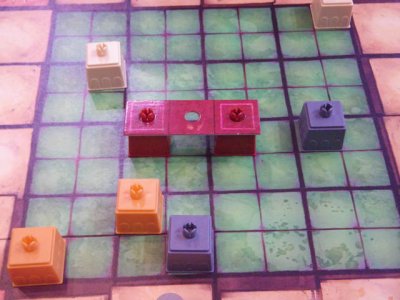 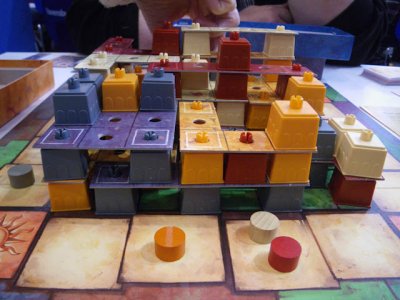 The game I participated in proved a little confusing in the beginning since none of the players was familiar with the available shapes of platforms. Thus, during the first few turns, we spent quite a lot of time with rummaging through our stock of platforms. But after we had overcome these initial difficulties the game progressed smoothly, until we started constructing the second floor. At that moment, the tactical elements of the game became much more obvious and thus we had to take our time in order to make the right decisions. Nevertheless, the game still proved rather fast paced. When it came to constructing the third floor, however, we had to pay considerably more attention in order not to lose track of the game and to make sure in particular that none of the players placed his or her building blocks onto the incorrect row or line. Moreover, as the buildings reach to the sky, it becomes rather difficult to detect the remaining free paces on the lower levels. However, these minor flaws did not compromise my pleasure in playing the game. Casa Grande presents some well-known game mechanisms clad in completely new 'clothes', the rules are very short and the whole game advances very quickly and entertainingly. Thus, it particularly is a pity that the material contained in the box looks rather sleazy - the publisher should touch this up! And, finally, in case you should wish to play Casa Grande with younger children, placing the building blocks on top of each other might prove a rather wobbly experience! After this first successful try-out I met with Frank and Marco again and together we strolled through the convention halls and gave some other games a try. Frank will share our experiences with you later - this leaves me with reporting on one other game. Sampling: DRAKO (REBEL.PL, Booth 4-311)
Three dwarfs versus one dragon. This phrase captures the whole story of Drako, one of the new games of REBEL.PL. One player takes the role of the Dragon who is decoyed by a dead sheep, the other one plays the three dwarfs who have set a trap for the dragon. Both players have their own set of cards that are shuffled at the beginning of the game. During his or her turn, the player may choose amongst the following two actions: he or she may either draw two new cards or play one of his or her cards. The cards allow the player to either move or attack the other player. Additionally, there are also cards which can be used as a defence against the opponent's attack. In order to carry out an attack, attacker and defender have to stand next to each other on adjacent fields. Moreover, players may also decide to carry out special attacks - provided they are given prompt opportunity: For one, the card Fire Attack allows the Dragon player to breathe fire in one of the six directions on the hexagonal board. Consequently, all the dwarfs in the line of fire get hurt save the Dwarf player is able to protect them by help of an appropriate defence card. Each of the three dwarfs is endued with a special ability. For the Dwarf player it is of utmost importance to see to favourably positioning the dwarfs so that they can concurrently attack the dragon from two flanks and bring their respective special abilities to bear, too. For example, one of the dwarfs may throw his net hence pinning the dragon down for a while - but, of course, the Dwarf player must also command the respective card to bring this ability into play. Another dwarf may attack the dragon from afar with his crossbow and, last but not least, the third dwarf may choose to put himself into a rage which allows him to perform one additional action. 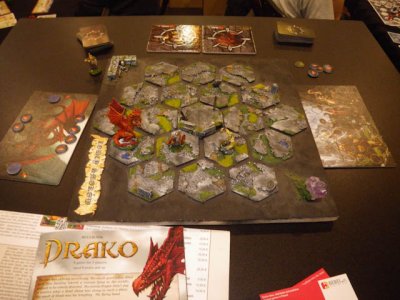 Obviously, the dwarfs all feature very potent abilities and, indeed, the Dragon player has a rather hard time winning the game. The best he can do is taking advantage of his ability to fly freely from one field to another - provided, of course, the Dragon player commands the respective card. But time is also on the side of the Dragon player. If he or she survives long enough, the Dwarf player will inevitably run out of cards and the Dragon wins the game. Thus, it is good advice for the Dragon player to avoid open conflict with the dwarfs as long as his or her cards allow him or her to flee the dwarfs. At first sight, this seems easy enough, however, each time I took over the Dragon's part during the sampling, the hiding places onto the board proved far too limited. Both players can take stick, but after a number of hard blows the characters the characters become more and more impaired. The Dwarf player separately notes down the wounds of each dwarf. After any one dwarf has suffered the fifth blow, he is knocked out and does not participate in the game any longer. As for the dragon, in case his dragon armour yielded to the dwarfs' attacks, the Dwarf player decides which one of the dragon's three special abilities to destroy: movement, flight or breathing fire. In case one of these abilities took the final blow, the dragon can no longer employ it. Thus, destroying the dragon's special abilities is very advantageous for the Dwarf player. But nevertheless, he or she will not win the game until the dragon is killed. In my eyes, Drako is a perfectly balanced game. My sampling ended with a victory for me as the Dragon player, but my dragon was heavily wounded and had already lost his ability to breathe fire and to fly. Indeed, I would not have lasted longer than one additional round. The photo shows a luxury version of the game which was, unfortunately, designed exclusively for use during the convention. The regular game's looks are more simple, it contains plastic materials (instead of pewter figurines) and an ordinary cardboard game board. But this will not deny my estimation that Drako is a very nice, fast-paced and highly entertaining fantasy oriented two player game. 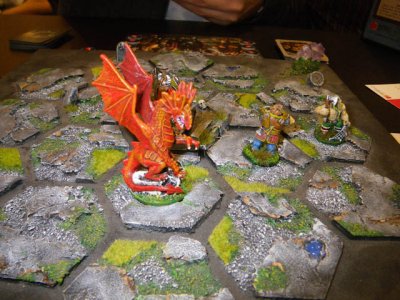 So much for today from me. Having just checked my schedule for the next days, I promise that there will be more to tell tomorrow! |
Getting the micro back from Ralf, let's now turn towards my account of the playtesting of Pret-A-Porter, because I really would like to tell you about this very enjoyable experience!
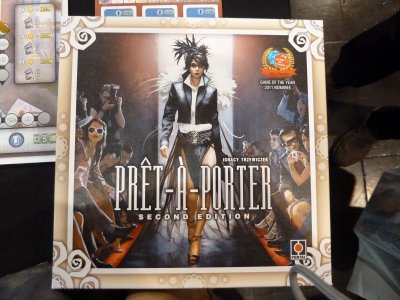
With a flood of games released for the hungry hobbyists each year, it gets ever harder for the authors to find fresh themes which have not been used on dozens of other games. As it seems, Ignacy did feel a flash of inspiration this year, because the world of fashion and models has not been used for a theme of any game I can remember. A refreshing new topic, and as my curiosity was also fired by some good looking images of the game's components I was more than eager to have a go at Pret-A-Porter!
The main gameboard is used for the players actions during the game, and here the game follows the modern trend by basing the players actions on a worker-placement-mechanism, even though the three playing pieces available to each player are not meeples but simple wooden tokens. Thus, in the course of a round, the players in playing order place their tokens at the different locations of the main gameboard, and once all tokens have been placed the locations are dealt with in a fixed order. Each of the locations actually can receive two or three player tokens (depending on the number of players), and it is even possible for a player to send more than one of his tokens to the same location - provided there is still room for the additional token.
The order in which the players have placed their tokens at a location determines the order for performing an action at the location, and so an early placement in some locations means that this player can choose from a broader range of available cards. This mechanism is followed at the locations where new employees, buildings, contracts and fashion designs can be obtained, and so a player needs to decide carefully where to place his initial token because the "pole position" in the other locations possibly will be taken by other players once the player gets around to place his second token.
Some other locations are more or less independent of the player order, since all players may perform the same action there if they were able to place one of their tokens at a free slot. An example for this are the three different locations where materials for the sewing of new fashion designs can be purchased, and at the bank where the players can obtain credits there exists no limit for the number of tokens to be placed.
However, before we go into more detail, let's first have a closer look at the game's setup and the player's aims. In Pret-A-Porter each player runs his own fashion company which is represented by a player board which each player has received at the beginning of the game. These boards are used to keep track of the players' monthly costs / income, and furthermore various tokens and obtained cards can be placed there. The boards also host a small distinction which is made between all companies, since every company is specializing in a specific type of fashion designs. In addition to the player board, each player also starts the game with two design cards which show (yet unfinished) designs for clothes. Each design belongs to a certain type (dress, trousers, blouse etc) and style (Boho, sports etc), and during the course of the game the players will aim to obtain and finish designs of matching styles because all cards with an uniform style may be included in a collection which can be presented at a fashion show. The fashion shows happen evenly spread four times during the game, and this will be the time when the players can turn their collections into money and additional company value, and at the end of the game the player with most money plus company value will be the winner of the game.
The game runs over a total duration of twelve months (rounds), and every third month will be a fashion show month in which a fashion show takes place. On the other hand, the first two months of each quarter are the preparation months, and here the players act by placing their tokens onto the gameboard to perform actions. As indicated, most of the actions available on the board either deal with the obtaining of new cards (employees, buildings, contracts and designs) or the purchase of materials (3 different types of manufacturers), and the players need to balance their actions in order to prepare for the upcoming fashion show month. Thus, it is important to get new design cards in order to assemble a collection of design cards with a uniform style, and when design cards have been obtained the players also need to purchase materials to start sewing on the designs they want to present at the following show. Each design needs two different material-cubes to finish it, and here come the manufacturers into play. As indicated, the players can choose between three different manufacturers, and here the conditions differ concerning both the quantities and choice of available materials. In addition, players also get Quality tokens from the manufacturers with each purchase, but once again the number of Quality tokens differs with each manufacturer. When a player has obtained the two materials required to finish a design, he simply places the two cubes onto the design in order to mark that the design has been sewn.
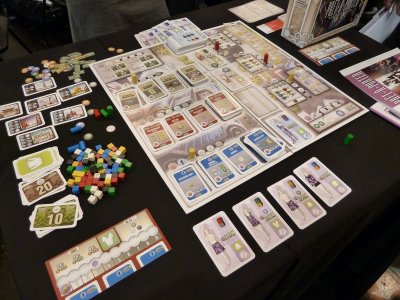
Employees, buildings and contract cards also can be obtained on the main gameboard, and together with the design cards a completely new display of available cards is revealed each round. All three types of cards give the players access to a wide range of benefits, covering many different aspects of the game. Quite important is the fact that the players can gain Quality, Trends and Public Relations tokens through some cards, and these kinds of tokens will be important during the fashion show months. However, the players have to choose new cards on the basis of their own strategy, since it is important for them to create windfall effects in the course of the game in order to reach maximum performance with their fashion company. Thus, it doesn't make sense to buy a wide range of buildings and hire a variety of employees, but instead a wise choice of matching cards will have a much bigger impact during the course of the game.
However, there are some common features of these cards which can be mentioned here. For one, both buildings and employees have a monthly cost which needs to be paid, and in addition a player also needs buildings to place employee cards if he should hire more than three employees. Both card types also can be upgraded for a sum of money printed on the card, and if a card is upgraded the benefit created by the card gets even better. Contracts on the other hand provide their usually quite strong benefits only until the next fashion show. At that time the player either must discard his contracts, or - if he has a negotiator amongst his staff - gain a prolongation for another three months with a reduced benefit.
All fashion shows were determined before the game started, and so a number of fashion show cards was revealed for each quarter. One fashion show takes place in March, two in June, three in September and four in December. During a fashion show month the players send their finished collections of designs to all fashion shows taking place in that month, and so the collections will have to compete in more and more fashion shows the older the year gets. During each fashion show, the collections of all players are compared on the following features: Quality, Trends, Public Relations and Quantity of finished designs, and the question on which feature the comparison is made is solved by a look on the fashion show card where a ranked list of all four features is given. Players winning in a feature will be assigned Star Points, and apart from increasing the sales value of the player's collection these points will be transferred into company value which will count towards winning the game.
During March, all four features listed on the one available fashion show card are compared in downwards order, with most Star Points being awarded for the winner who is best in the first feature and the lowest amount of Star Points assigned to the winner of the fourth and last feature. The situation changes over the year in so far as the number of fashion shows increases by one each quarter, but the number of compared features decreases by one each quarter. So, the two fashion shows in June only are compared on the first three features, the three fashion shows in September only on the first two features, and the four fashion shows at year's end only on the first feature listed on each fashion show card.
At this point we are finally touching the centrepiece of Pret-A-Porter, since the changing composition of fashion shows and features upon which the collections are compared is rather important for the strategic impact of the game. At the end of a fashion show month each player sells the collection of designs which he has sent to the shows, meaning that he looses all these designs but gains a nice income which can be increased even more if the player earned some Star Points at the shows. However, the loss of the designs means that the players always have to plan ahead for the following fashion shows, because it would be disastrous to start into the next two preparation months nearly empty-handed. The possession of matching employees and buildings is indispensable at this point, because the effects created by such cards give the players many possibilities to increase their company performance.
However, as the year goes by, competition between the players gets ever harder because the fashion show cards which were revealed for September and December actually might bring a shift of emphasis towards specific collection features. During March, the single fashion show brought a competition for all four different collection features - even though each feature had a different importance. However, at the end of the year the single feature which will be compared might be the same for two or more fashion shows, and so the second half of the year usually will increase player competition for design cards matching the demand of the year's end shows. In addition, all four fashion shows at year's end will award a high amount of Star Points for players winning these competitions, and so author Ignacy Trzewiczek succeeded in building up a nice arc of suspense for the course of the game.
The game contains many set screws which the players may try to manipulate to their own ends, and the well constructed rules allow for different approaches. To allow different ways of financing, the game includes an interesting system of bank credits and private loans which stand at the disposal of the players, but the cheaper bank credits are based on the size of the players' collections since the banks need securities for their money (what a surprise!!!). A private loan on the other hand can be undertaken at any time during the game, but it is much more expensive to pay back and so usually is avoided. Another interesting twist is the Preparations action on the gameboard. It is the last board action which is played each month, and since the players can choose between different benefits here the action often is chosen to bring along some last-minute changes for an upcoming fashion show month. However, this is the only action which is dealt with in a backwards player order, and so players who have placed their token early may act after later players and thus counterbalance a disagreeable action.
There are quite a few different ways available for the players to gain the desired Quality, Trends and Public Relations tokens which are needed to compete in fashion shows, and here yet another strength of the game appears because the players are not purely depending on gaining the right employees, buildings and contracts. While the sheer choice of cards helps, there are other ways to gain such tokens (quality from manufacturers, Public Relations from a Preparations action etc.), and so the players remain masters of their own fates if they are able to keep a good timing.
Overall, the rules of Pret-A-Porter are very rich in content and promise some quite interesting competitions at the vanity fair of the world of fashion, and even players who have nothing in common with the world of designers should be tempted to give this game a try!
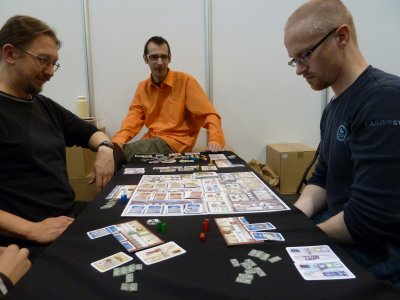
Originally I had intended to have a look at the new Hades-Expansion for the MATAGOT-game Cyclades today, but unfortunately MATAGOT once again is having some problems with the delivery of their new games. I was told at the booth that they would not be available here at the show today, and so Ralf and Marco (who had also finished their game of Drako stayed with me at the joint booth of PORTAL and REBEL.PL for a meeting with Maciej Teleglow from REBEL.PL. We could either go for a testing session of the new Broad Peak Extension for K2 or City Tycoon, but since I had heard some very good comments on the latter game from fellow gamers we decided to start our careers as city designers!
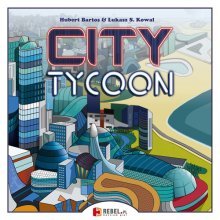
As indicated, the new game from Hubert Bartos and Lukasz Kowal puts the players into the position of investors who have decided to build a new city right from scratch, and all the players receive for this venture is a decent amount of starting capital which they will need to pay for their first buildings.
The game is played over a total duration of four rounds, and for each of the rounds exists a separate set of city tiles so that the available tiles get stronger and more expensive with each round. Set aside are stacks with tiles electric power stations and water works (six tiles of each), and these tiles are sorted so that the cheapest tiles are on top and the more-expensive, better performing tiles at the bottom of these stacks. To finish preparations, a small city center featuring four tiles including one electric power station and one water works is set up in the middle of the table, and during the course of the game the players slowly will build the city around these four initial tiles.
Each round begins with the players taking and shuffling the deck of tiles for the current round, and from this deck each player is dealt a total of six tiles. Following the "choose one and pass on" mechanism known from 7 Wonders, each player chooses one tile for his hand and passes the rest to the player to his left. Then, once again the players will choose one tile for their hand, and this procedure continues until all players have received a hand of six tiles which they will use during this round.
Taking turns, each player now can perform an action with a tile from his hand until all players have used all six of their tiles, and during their turns, the players may use the tiles for three different purposes. For one, they can be built if the player decided to pay the costs printed on the tile, and then they must be placed horizontally or vertically adjacent to an already placed city tile. On the other hand, a player who is short on money also can opt to discard a tile, and in this case he will receive a small amount of money which he may spend on later projects. Finally, a player also may opt to build either an electric power station or a water works during his turn, and in this case he takes the uppermost tile from the corresponding stack, adds it to the city and pays the building costs. In addition, one city tile from the player's hand must be discarded without compensation, because otherwise a player could gain a free turn from building an electric power station or water works.
But what can the city tiles actually do? When all players have taken their six turns the round ends with a phase in which the abilities of the tiles are used and energy/water cubes are consumed. Each player only may use his own tiles (they are marked with a little token of the player's colour upon placement), and most of the tiles have consumption values for electricity and/or water which - if supplied with matching electricity and water cubes - can result in the production of money or victory points. Once again taking turns, the players now need to move matching energy and water cubes from the power stations and the water works towards their own tiles, but here they face the restriction that only cubes taken from their own power stations and water works can be taken for free. If a player needs one or more cubes from another player or the public facilities in the town center, he will has to pay for acquiring these cubes plus every space through which the cubes are moved and which is not owned by the player.
If matching cubes are supplied, the production of the receiving tile is triggered, and the player may receive money, victory points or even a luxury goods cube (depending on the abilities of the city tile). Luxury cubes can be placed at tiles which have the ability to turn them into money and/or victory points as well, but usually the income generated by the consumption of such a cube will be higher than the income which can be created through electricity or water cubes.
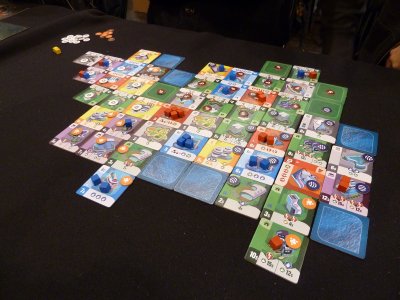
While this all will sound fairly streamlined, it should be pointed out here that success in City Tycoon is depending to a very high degree in a good timing, because the supplies of electricity and water which can be used each turn are quite limited due to the scarce placement of power stations and water works. Usually all such facilities produces a fresh supplement of cubes at the beginning of a consumption phase, but with the players activating their buildings one by one the stockpiles or energy and water are drained rapidly. At this point the game actually gets quite captivating, because the players are faced with the dilemma that they want to use the abilities of their buildings in the most profitable order while at the same time they need to keep an eye on the dwindling supplies of cubes within the city. The abilities of other players' city tiles and the delivery routes and distances for energy and water cubes all must be taken into consideration, and this may result in quite interesting developments and activation sequences during the consumption phase.
The timing aspect is also stressed by the fact that the playing order for a whole round is decided on the basis how wealthy the players are after the consumption phase at the end of a round, and so the player with fewest money becomes new start player with all others following in order of their own wealth. While such a balacing act might seem unfair against a successful player, it must be kept in mind that money is not the same as victory points, and so the key to success also lies in the generation of victory points without hoarding too much money. After all, the players are investors!
The game also offers some very interesting possibilities for strategic gameplay, because it may be wise for a player to build a building directly adjacent to a power plant or water works erected by an opposing player. This new building now can consume cubes from that station for a comparatively low price, while the owner of the station probably would have preferred to use the cubes for consumption at his own city tiles. If they players are familiar with the composition of the city tiles deck for each round, they may also try to plan ahead for stronger tiles appearing in the following rounds, and so City Tycoon demands a quite good balancing between current needs and future designs.
Unlike other games where each player tries to hone his own production chain to perfection, the stepwise process of all players building the same city and the consumption phase which ends each round of play offer a much higher potential for player interaction than many other games. There are multiple ways to win the game, including the investment into buildings which create victory points on a one-time basis or by going for the production of luxury goods cubes on a larger scale. These cubes have the unbeatable advantage that a player takes them into his personal stockpile when they are produced, and he may consume them later on (even in a later round) in any of his city tiles anywhere in the city without paying delivery costs.
These differences give City Tycoon a quite outstanding quality in comparison to many other production-type games, and after their success last year both Polish publishing houses REBEL.PL and PORTAL once again have shown that they have not only catched up with the rest of the market, but they are actually able to produce games for hobbyists which meet very high standards.
Both playtesting sessions of Pret-A-Porter and City Tycoon left me hungry to play the game again, and I guess that they will come back onto our playing table soon after the SPIEL has ended.
However, first they have to go through final inspection, and here our cats Pegasus and Kira helped me sort through the stacks of games which I have carried home today. They seem to share their owners' special weakness for gameboxes, although they actually like them most if they are empty so that they can sit in them!
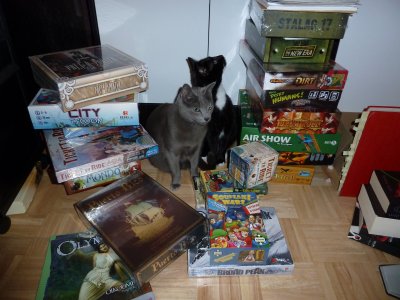
I hope you like my presentation of today's great games, and meet you all back here for the next convention day tomorrow!!!
Ooops, I nearly forgot: For those of you who actually attend the SPIEL! See you tomorrow at 3 PM at the booth of Boardgamegeek (Hall 10 booth 40) for the awards ceremony of the International Gamers Awards!
The show must go on!!!
Yes, here we are again, after another great day at the SPIEL '11.
The weather once again has changed here in Essen, and a bright blue sky greeted me this morning when I went the few meters towards the show. In front of the middle entrance a crowd of people was gathering, but if I remember correctly the crowds have been distinctly bigger in previous years. After all, it's still a normal school day today, and I guess that the absence of families with kids could still be felt.
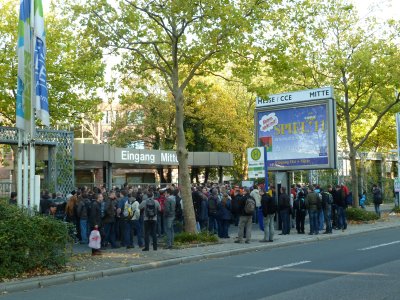
My first stop for the day was planned to be at the booth of 2F-SPIELE, since Henning Kroepke had kindly reserved for me a seat at a table for playing Funkenschlag - Die ersten Funken. This stone age game by Friedemann Friese is set in the gaming family of Funkenschlag (Power Grid), but as this year the 10th anniversary of Funkenschlag can be celebrated it is designed as a new standalone game with its own twists and turns despite the fact that it uses some of the mechanisms of Funkenschlag.
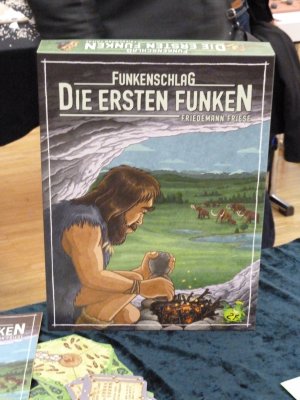
Each of the players becomes head of a stone age tribe, and the first player to get thirteen of his clan members onto the modular gameboard will be the master of all tribes and winner of the game. However, the way to this aim is quite long, since the players usually start the game with just one or two clan members on the board. As indicated, the modular board can be adjusted to match any number of players from two to six, and the different areas on the board show the different types of food which can be gathered there: berries, fish, bears and mammoths. However, in order to gather food from these spaces the players do not only need a clan member there, but in addition they also will need a matching technology card which allows them to gather (or hunt) this specific type of food. After all, do not forget we are dealing with stone age people!
Apart from additional clan member figures, each player starts the game with five units of food and one initial technology card, the herbs gatherer. Food serves as currency in this game, and the herbs gatherer technology allows its owners to gather one unit of food during the hunting phase for free. But to be honest, this one unit only can be seen as a start because each clan member on the gameboard will consume one unit of food each turn in the food consumption phase.
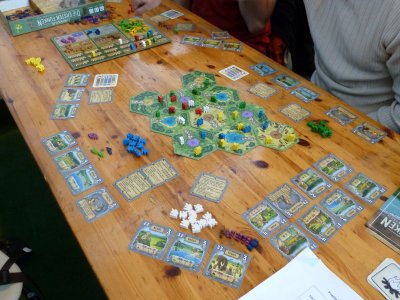
However, before food can be hunted and consumed, the players first need to get technology cards which enable them to get food or which might trigger other useful benefits. Before the game started, a display of eight technology cards with card order numbers from seven to fourteen has been arranged in ascending order into two rows, and for all technology cards the general rule can be given that the cards with the higher card order numbers will offer better benefits than those with lower card order numbers. So, the deck contains for example several cards for farming (gathering food without the need of clan members on the gameboard), but while the lower cards spread into the deck only allow the production/gathering of a few food units, the cards with the higher card order numbers allow a gathering of up to 10 units of food! The technology cards needed for the gathering / hunting of food from the different spaces of the gameboard are designed in the same manner, and so carrying baskets (berries), fishing rods, bows (for bears) and spears (for mammoths) with high card order numbers enable their owners to gather more food of the matching type than cards with low order numbers.
Each of the technology cards also has its price (to be paid in units of food), and once again the price is lower for cards with a low card order number. Only the first four cards may be bought at any moment, but the lowest card of the following four cards will take the free space once a card has been bought. Then a new card is revealed from the deck and added, but since only the eight initial starting cards were placed in a fixed order, the new card may have any card order number. Thus, a new card is not always placed at the end of the waiting line, but instead it is placed at the correct rank between one card with a lower and one card with a higher card order number.
The order in which players may buy these cards is depending on the player order, with the first player being the player with most clan members on the gameboard. However, a quite interesting variation of a normal buying or auctioning process can be experienced here, since although the first player will chose one card for buying, that card first will be offered to all other players in reverse player order! Only if no other player wants this card the first player will be allowed to buy it, but if it is bought by another player then the first player again has to choose one available card and offer it to the other players. However, all players who have obtained one technology card are out of this process, since each player only may acquire one technology card per turn.
This mechanism poses an interesting, speculative challenge to the player choosing the current card, since if the player desires a specific card it may be wise first to offer other cards in the hope that the other players possibly will take these. However, since the display of available technology cards is visible for everybody, all other players also may guess which card might be favoured by the active first player, and so they may keep low until the desired card is offered. And, if the first player chooses a totally unattractive card, he always has to face the danger that he might end up with this card himself!
When each player has bought one technology card, the round continues with the gathering/hunting of food. Once again going in reverse player order, the players now are allowed to use their technologies to gain food. As indicated, farming technologies will create some amount of food without the need of clan members on the gameboard, but all other types of food require both a clan member within a fitting space and the matching technology card to gain food from that space. As might be guessed, the bigger the animal the higher its food value, and so the mammoth actually has a value of four food units whereas berries only count for two food and fishes and bears for three.
The observance of the reverse player order is quite important here, since only a limited amount of the different types of food is available for gathering/hunting each round (apart from grain, since the farming stockpile is endless). Thus, the player with the biggest clan on the gameboard collects his food last and may actually run out of stocks, and this is a good example of the balancing which Friedemann Friese has found for this game since the players should follow a strategy of keeping a low profile and not simply try to enlarge their clans whatever the cost. The art of playing this game lies in avoiding a too big clan whithout falling too far behind!
When all players have received their food, they must pay one unit of food for each of their clan members on the gameboard, and afterwards they may use left over food to place more clan members onto the board. It is important to know at this space that a player only is allowed to place one of his clan members into each space, and so the players will have to cover a wider area with their clan members in order to get closer to winning. The first clan member per round costs one unit of food, but if more than one clan member is to be placed within the same round, the price to pay is stepwise increased by one for each additional clan member which the player wants to bring onto the board. In addition, the players face restrictions on the board since all figures must be adjacent to already placed figures of the same player, and so the situation will come up that a placement into an empty space is not longer possible because of other players' clan members. In this case the price for the placement is increased by one for each clan member in the same space (including the player's own one), and so a placement may get considerably more expensive.
After all players had a chance to add new clan members to the gameboard, the current round ends with a discarding of the technology card with the lowest card order number is discarded and replaced with a new card from the deck the stockpiles of available food are replenished for the next round, and a new player order is determined on basis of the sizes of the clans of the players. If two clan have the same number of members on the gameboard, the player with the higher numbered technology card will be placed prior to the other playr in the now player order.
Some other rules add additional finetuning to the game, and here the knowledge technology cards may be named which can be acquired just like any other technology card. These cards provide special abilities, so that a player who can create fire becomes immune against the spoiling of his food stockpiles (all other players loose one third of their food each round after the acquiring of new technologies), or a player who has discovered the art of speech is allowed to place his clan members for less food into already occupied board spaces. An important difference to other technology cards is that a player may hold any amount of knowledge cards, whereas the total amount of technology cards used for gathering/hunting and farming is limited to a maximum of three cards.
Once again Friedemann has created a rather challenging resource-magagement game, and even though the game uses some ideas from Funkenschlag the variation seems to be big enough to warrant the release of a full new game. The mechanisms for the acquiring of technologies and the gathering of food work rather smoothly with the reverse player order approach which is followed at many occasions, and so the players are challenged to make the most with as few clan members on the board as possible. Food is needed not only to buy and support the clan members, but also for the acquiring of new technologies, and so these different uses need to be weighted against each other. Furthermore, the players also should take their available technologies into consideration and base their future designs on them, and so a successful survival in the stone age becomes a rather tricky undertaking!
Quite surprisingly, I liked the quicker and more direct competition in Funkenschlag - Die ersten Funken even more than in the original game. However, this is partly due to the fact that the theme and the artwork much more my liking than the rather technical drawings of Funkenschlag. Still, it is a very cute feature that each technology card in the game shows its own drawing, and whereas the cards with the lower card order number show hairy Neanderthal men and women, cards with higher numbers show growing signs of settlements and civilization. If seen in order, the technology cards tell a story of their own, and so Funkenschlag - Die ersten Funken is offers some rather nice ideas even outside the filed of rules and mechanisms. Friedemann really created a very nice anniversary gift for all friends of his games!
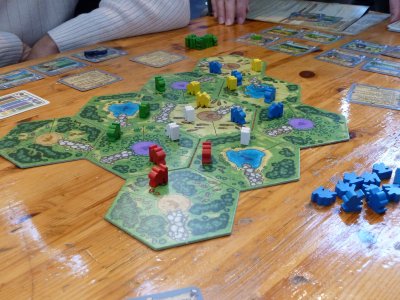
During the last few days I have also kept you updated on the delivery status of the highly awaited Flash Point - Fire Rescue game from INDIE BOARDS AND CARDS. Yesterday evening Travis Worthington finally could confirm that the game has cleared customs and arrived at the SPIEL, and so nothing could keep me from having a closer look at the hard working of a group of firefighters!
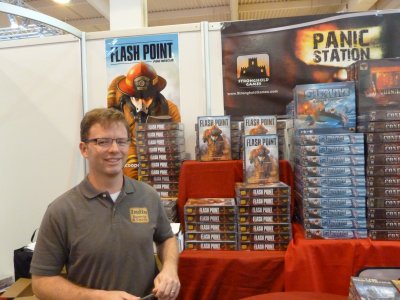
Flash Point - Fire Rescue is a cooperative game for up to six players, but because of the automatic mechanics for the spreading of fire it can be enjoyed even as a solo game. The gameboard displays a house in which a fire is blazing, and so fire markers are distributed in some spaces at the beginning of the game. For the basic game these fire markers will be placed at fixed locations, but later on a random setup can be chosen so that the fire can come up in different locations. In addition to the fire, three point of interest (POI) markers also are distributed face down on the gameboard, and during the course of the game the players will have to find out whether these POI-markers are dummies or victims in need of rescue. Whenever a dummy is found or a victim is rescued, a new POI-marker is drawn and placed on the board, and the game is won when the players succeed in rescuing a total of seven victims. However, the maximum number of victims in a game is ten, and so the players will loose if four or more victims are killed by the fire.
The players start with their Fire-meeples outside the house, and during their turns they may act on a traditional action point mechanism. Thus, each player may spend a total of four action points, and these may be used for moving, carrying a victim, opening / closing doors, extinguishing fire and chopping down walls. While a normal move costs one action point, other actions like the carrying of a victim or the chopping of a wall consume two points, and even more tricky is the extinguishing of fire. It costs one action point to turn a fire marker from its fire side to the smoke side, but smoke markers are liable to re-ignite and so it's better to remove them by spending another action point. Following this straightforward approach, the players move through the house, trying to keep the fire at bay while at the same time exploring POI-markers and rescuing victims by carrying them outside the house.
After each player's turn, the "artificial fire intelligence" takes its turn by advancing the fire situation on the gameboard. Two dice are rolled to find a space with corresponding coordinates, and a new smoke marker is placed at that space. However, if the marker would be placed on top of an already existing smoke marker that marker will be turned to its fire side, and likewise the smoke will also ignite if it is placed next to an already existing fire marker. Even worse is the situation if the smoke would be placed atop an already existent fire marker, since now an explosion will take place, spreading fire on all four neighbouring spaces and possibly destroying walls and doors. After the fire has advanced in this phase, a final flashover takes place which means that all smoke markers neighbouring fire markers will ignite as well, and in this fashion the fire will slowly spread through all of the house unless the players can find a way to keep the fire at bay.
The rules introduced so far already line out the structure of the basic (family) version of the game, but things get much more interesting when the additional rules of the expert game are used. Now each of the firemen becomes a specialist with his own unique ability, and the players are forced to cooperate at a much higher level in order to use these abilities to their common success. So, the Fire Captain gets two extra action points which he may spent on moving other characters around, the Paramedic can treat victims so that they can be moved quicker, or the CAFS (=Compressed Air Foam System) Firefighter gets additional action points for extinguishing fires.
Quite interesting is also the role of the Driver / Operator, since he is very effective when the players want to use the newly introduced fire engine which is parked outside the house. The engine may park adjacent to any quarter of the house, and a fireman manning the engine may move it or fire it's deck gun, splashing a powerful gust of water on a random target space within the house's quarter and all adjacent spaces. As indicated, the Driver / Operator character is more effective here, since he may operate the engine at half the normal cost.
However, with these interesting options increasing the firefighters' effectiveness, the game's balancing needed some adjustment as well, and so the challenge is increased by some Hazardous Materials ("Hazmat") and Hot Spot markers which had been distributed at the beginning of the game. If the fire consumes Hazmat, an explosion takes place spreading fire in the usual manner into all adjacent spaces, and so the Hazmat either must be carried out of the building or removed from play by the Hazmat Technician specialist character. Hot Spots on the other hand may cause fire to come up in additional regions of the gameboard, and so the players need to be on their guard because a quickly spreading fire may endanger the structure of the whole building and cause it to collapse.
Considering the rules' mechanics Kevin Lanzing has chosen a very traditional approach for his game, since neither the action point mechanism nor the approach used for spreading fire seem to be an absolute novelty. However, sometimes known elements can be assembled into a new creation, and here kudos must be given to Kevin for his masterful creation of this challenging and captivating firefighting game. The straightforward character of the rules makes it very easy for all participating players to grab the basic concept of the game, and this easy accessibility is not lost even when the expert rules are used. Quite the opposite, the game gains momentum especially through the use of the different specialist firemen, since every player now gets the feeling that his character takes a very important, unique role in the joint efforts to solve the mission. Thus, playing depth is increased both in terms of strategy and atmosphere, and it can be assumed that players will quickly develop a clear preference for the expert game!
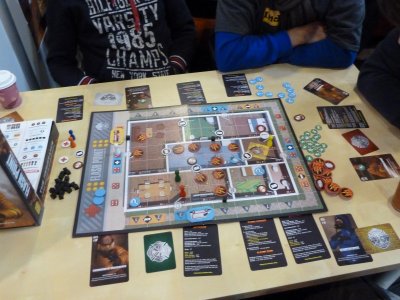
The year 2011 seems to be the first year in which game designers have resorted to fundraising via the website of Kickstarter.com on a major scale, and also the roots for Flash Point - Fire Rescue go back to Kickstarter-funding. However, this project differs considerable from some other projects concerning the funds level, since Travis Worthington found 845 backers for Flash Point - Fire Rescue, and together this group of people sponsored the amazing amount of $ 51,398! With this level of funding, the equipment and extras included with the game could be considerably increased, and so the game is now available with wooden Fire-meeples, an additional two-sided gameboard with two new buildings, a promo card and a scenario-book.
For my taste the story around Flash Point - Fire Rescue is a very good example how Kickstarter may be used to bring an excellent game to life. All backers who supported the initial project received the game plus all goodies at a reduced price in comparison to the final sales price, but INDIE BOARDS AND CARDS owner Travis Worthington did not induce people to join this project by promising all additional goodies to be "Kickstarter only". Thus, customers of the SPIEL convention could get the scenario book, the additional gameboard and the promo specialist for a surcharge, and so the exclusivity of these goodies is not used as a leverage to get more backers at Kickstarter. In comparison to WHITE GOBLIN GAMES who give a second promo card for Revolver only to people who spend over 120 Euros to buy all six of their new games (!?!), the approach choosen by Travis seems very commendable, even though the limited quantities of extra goodies available here at the SPIEL sold out very quickly!
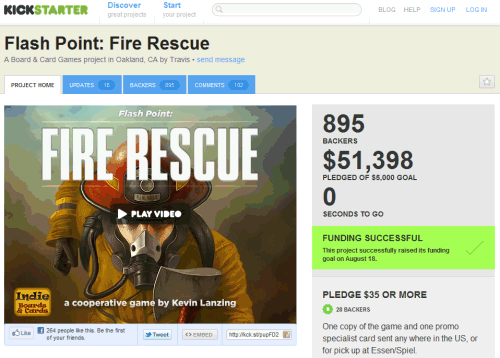
After these two very interesting playtesting sessions in a row, I had to get a bit of fresh air before I wanted to look for another game which had caught my interest while wandering through the halls, and so I took a short break for a stop at an upper level balcony of the convention halls. Here you have a very nice view of the neighbouring GRUGA-Park, and I enjoyed the sunlight and crisp, cool air outside!

Inside again, I traversed a few halls to reach the newly added Hall 7, and here I visited the booth of MINION GAMES to check out whether there was any news about their games which were delayed in production. Once arrived, I met James Matheson in a quite happy mood, because he had been lucky and final copies of the Fantasy-adventure game Venture Forth had indeed been delivered to his booth!
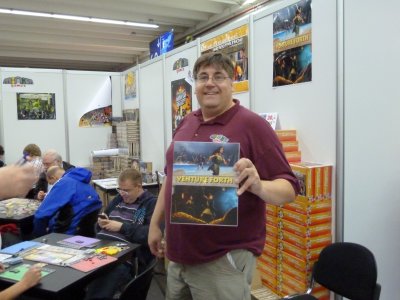
Adventure boardgames are a classic category in the world of games, ranging from all-time classics like Talisman or Heroquest to big-sized games like Warhammer Quest or Arkham Horror. Many players around the world are fond of these games due to their fantastic background stories - you venture forth with your own character in search of gold and glory. However, looking from a boardgamer's perspective, this boom of adventure games always has been a bit of a paradox, since the playing mechanism of many of these games can be reduced to a core which is based on simple dice-rolling. Okay, to be fair it should be stated that Arkham Horror is somewhat more sophisticated than the other examples mentioned above since it demands some real decisions of the players, but nonetheless a high element of luck is characteristic for all of these games. So, it must definitely be the topic which is attracting so many gamers, and this brings up the question why so few adventure games with a more strategic background have been created so far.
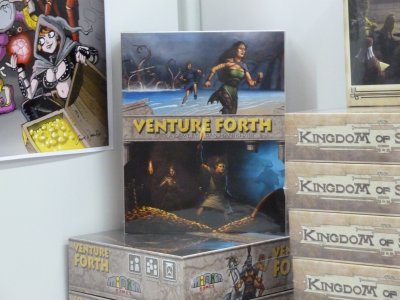
Keeping this introduction in mind, I was even more happy to see Venture Forth here the SPIEL 11, since this game by Dan Manfredini actually seemed to include a somewhat higher strategic approach than many other adventure games. Like Flash Point - Fire Rescue, Venture Forth is a project which was funded through the Kickstarter website, although the final level of funding which was received for this project was considerably lower.
The game is set in Ancient Greece, with the players facing a somewhat functional gameboard showing five different locations (country, mountains, 2 x wilderness, seashore) and some paths interconnecting these locations. The paths are made up by two to three spaces, and in these spaces encounter cards (heroes and enemies) will be placed during the course of the game. Each player begins the game with one semi-randomly chosen level-one adventurer, some coins and a random starting hand of five encounter cards. Each player places his pawn at one of the locations on the gameboard, with the restriction that each player must begin at a different location.
The core element of the game will be the adventures which the players parties will face when travelling from one location to another. However, before a player may chose this "venture forth" action which will initiate a voyage all spaces on the path between the starting location and the destination must be filled with encounter cards. Thus, at the beginning of the game no player is allowed to travel because no path is ready, but instead the players will take turns placing cards from their hand onto empty path spaces of the gameboard.
Two factors must be observed when placing a card, and this is the colour of the card and the resource symbol depicted on the path space which is covered by the card. The colour of the card determines the area in which the card must be placed, e.g. a seashore card must be placed on a path space which is adjacent either to the seashore location or to another seashore card. All encounter cards are placed openly, so that each player knows which adventurers and enemies will wait on all spaces. The resource symbol on the chosen space on the other hand is used to determine which kind of benefit the active player will get for the placement of his card. These benefits range between gaining coins for the player's purse, will cubes to place on the player's adventurers or a randomly drawn explore token which the player places openly adjacent to a path which has not yet received an explore token. After placing a card the players are allowed to draw a new encounter card to refill their hand.
As can be seen the placement of cards onto the gameboard serves two purposes at the same time. On the one hand the pathes slowly fill with cards, meaning that the point comes closer when the player's may start travelling between locations, and on the other hand the placement of a card is also profitable for the active player because he will get some money or will cubes for his adventurer(s). This idea already shows a bit of the tactical approach which is chosen in Venture Forth, because players will have to take a number of factors into consideration upon placing a new encounter card. Which benefit will they gain for the placement, at which locations are the parties of the opposing players, and will the placement of the new card actually be unintentionally helpful for an other player?
If, during a player's turn, a path connecting the current location of his party to another location is completely filled with encounter cards, the player may chose the "venure forth" action and travel to the new location. Now all spaces of the path will be encountered on a step-by-step basis, but all of this will happen within the same turn of the player. Path spaces containing adventurers are easy to deal with. The player either spends an amount of money shown on the card to hire the new adventurer for his party, or he simply moves on and ignores the adventurer. Enemies on the other hand are more tricky, since they bear a power value which must be overcome in order to slay the enemy and to avoid damage. A player may chose to give up a will cube on one or more of his adventurers in order to double the power value of that adventurer for the duration of this single encounter, but if the total power value of all characters in the player's party is not high enough to overcome the power value of the enemy card the player is forced to take damage in form of the loss of will cubes or coins, or - even worse - by adding a despair cube to one of his adventurers. The despair cubes will give negative victory points at the end of the game, but there are some possibilities to remove these cubes.
Upon arrival at the new location all defeated enemies will be removed from the path, whereas all cards remaining on the path will be rotated 90 degrees. If they already were rotated when the player ventured forth, the cards are also removed even if they were not hired or defeated, and so each card remains on the board for a maximum of two travel actions on this specific path. In addition, if there is an explore token next to the path, the active player is entitled to take the token in order to receive benefits like money and a treasure card. However, in most cases these benefits come at the price that an additional despair cube must be suffered by one character as well. The treasure cards each have a treasure point value and a one-time ability, and the player may opt either to keep the card until the game's end for scoring the victory points (provided the card then can be associated with an adventurer matching the treasure's type), or he may use the card's ability and then discard it.
A considerable amount of playing depth is added by the fact that each adventurer card not only possesses a power value which is needed when facing enemy cards, but furthermore each adventurer also is driven by a specific ambition which he wants to fulfil. Various ambitions exist in the game, and like the Poet whose ambition to write an epic tale is fulfilled when encountering an enemy with 10 or more power, all other ambitions likewise are triggered by specific events during the game. When an adventurer's ambition is triggered, the active player is allowed to discard will cubes from this adventurer in order to convert these into victory points, the loss of a despair cube and possibly a levelling up of the character, with the exchange rate being depicted on the adventurer's current level card. Each adventurer starts on level one, but - as might be guessed - the exchange rate becomes better with each new level. When the adventurer levels up, his level card will be exchanged, and all adventurers may go up to level three. At that level they will get an additional special ability which can be used for the rest of the game without the need to pay will cubes for its activation.
Finally, it should also be noted that each location on the gameboard contains a temple dedicated to a different Greek god. Instead of playing a card or venturing forth the active player also may opt to visit the temple a the current location of his party, and here money may be spent ("offered") on new will cubes, a free transport, additional turns etc.
The game ends after the round when the last (22nd) explore token was placed on the gameboard next to a path, and now the players sum up their victory points. During the course of the game victory points could be generated by spending will upon the triggering of an adventurer's ambition, and now at the end each remaining will cube and each two coins will be worth an additional victory point. As indicated, each adventurer in the player's party now also can be fitted with a matching, unused treasure card in order to score victory points as shown on this card, and some bonus points also are assigned to the player who has collected most explore tokens. Finally, three points will be lost for each despair token left on a player's adventurers, and the player with most victory points will have won the game!
Dan Manfredini has identified one of the big weaknesses of traditional adventure boardgames, and this is the random card-based event mechanism which is used in games like Talisman. In these games players move, draw a card and see what happens, but they have no real control of their fate and they cannot make real tactical choices. This is the point where the playing mechanism created for Venture Forth builds on, since here all the events which may happen on the different paths remain in control of the players. So, the players can try to place useful cards close to their own party in the hope to get these cards, while other players may add challenging enemies to the same path in hope making travelling more hazardous. While it is true that this mechanism works better with a full cast of four players due to the fact that more competition exists on the small gameboard, the game still can be played with two players at a more tactical level. And, as indicated earlier, the players also need to consider the benefits they may get for the placement of a card (as shown on the path spaces), and taken together all these elements effectively eliminate the drawbacks which are associated with the traditional mechanism of drawing random events.
What is more, no dice is needed in Venture Forth, since all information is accessible to the players and outcomes of encounters can be calculated with ease. Instead, the game is focused on a clearly discernible strategic approach which forces the players to weigh the banes and boons of each travel action, and this gives Venture Forth a playing feeling which could not be found in any of the older classics. However, the magic known from adventure games is not lost, but instead character abilities and the possibility to level up are cleverly integrated into the general playing mechanism.
Overall, Venture Forth is a very convincing game and yet another splendid example of the things which may come to life through collecting funds by a Kickstarter-project. The game offers a nice, new approach to the experience of adventuring, and apart from the slightly simplistic gameboard graphics all components are up to modern standard. Especially the artwork chosen for the encounter and treasure cards is quite beautiful, and so you should venture forth in order to search for this great game!
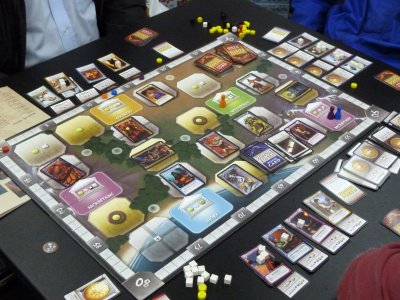
Actually, the delivery of Venture Forth was not the only happy ending which happened today. Somewhen during the afternoon, the Hades-expansion for MATAGOT's CYCLADES was finally delivered, and I have also run into Ferdinand de Cassan who happily told me that the Untermieter-giveaway for Pantheon would be available tomorrow at his booth of ÖSTERREICHISCHES SPIELE MUSEUM(9-14)!
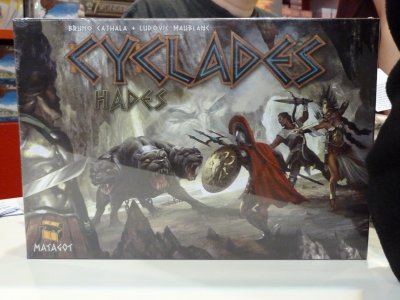
After this third playtesting the International Gamers Awards ceremony at the booth of Boardgamegeek was approaching, and there I had arranged to meet with my co-author Ralf to exchange the news of the day. Thus, before looking at the ceremony, let's hear Ralf's account of the day!
|
My second day on the convention began much more crowded than the last one. The first queue began outside in front of the entrance. Having entered the halls I decided to put my jacket into my backpack, because the time to hand it at the cloakroom could be used better. After a quick look at the big halls I rushed forward to the halls with the smaller publishers where I still could find some empty tables. Introduction: MARE BALTICUM (Gry Leonardo, Booth 4-120)At the booth of the Polish publisher GRY LEONARDO I was attracted by Mare Balticum, the new game from Filip Milunski who had presented Magnum Sal at the SPIEL last year. With its unique design it is one of the eyecatchers of this convention for me. Beginning with the box and ending with the the tokens it has amazing graphics of modelled clay. Well this is not exactly right. They told me, that the prototype was really made of modelled clay and only then the graphics were transferred. They promised to bring the prototype to one of the next conventions, but only if they are able to find a bigger booth. The graphics are truly a little bit unusual for a game about fishing, it reminds of a comic for children. This excellent design can also be found in the simple, but excellent rules (you can download them for free). But what can one expect of such a game? Clearly it is designed for families and I think that it also works with smaller children. The duration is quite short, only about 30 minutes are needed for a whole game. In the game each player controls his own fishing fleet consisting of five fishing boats. A lot of fish and amber tokens are placed randomly on the board that shows us the Baltic Sea, divided in shallow and deep water spaces. In a turn a player can perform three actions. First he can sail a boat to any space on the board, as long as all of his ships are still connected. So in reality he advances with his whole fleet on the board. Fishing is the next possible action. With one of his boats the player can take a token from the board. Amber goes directly to the player's warehouse, the fish otherwise is put on the player's mate. This represents the cargo space. But because this space is limited, it is necessary to unload it on a port to get the fish to the warehouse. Not all kind of fish is taken by every port and so it is sometimes necessary to sail to distant ports to unload all of the cargo. Empty spaces on the board are filled up from a bag. In this bag time tokens are mixed with the fish and amber tokens. Whenever such a time token is drawn, each player must play one of his company tokens. Four of these tokens are for specializing in one kind of fish. The player then places the company token with multipliers from 0 to 4 secretly on a special kind of fish. In the scoring phase at the end of the game, the value of the fish collected by the player and transported to his warehouse is determined by this multiplier. One of the company tokens works different. It is a tax token and the player has to pay two fishes out of his supply, of course it is not possible not to use this token. The game ends after the sixth time token is drawn from the bag. Two optional rules can be used for experienced gamers. The whole game is quite simple. But still it seems that a lot of other players falls under the charm of Mare Balticum. The reason is the great, unusual artwork combined with the consequent and intuitive game play and the short game duration. I think it could be perfect for a family game or a filler for the experienced gamers, since complex tactical or strategical game moves should not be expected from the game. Unfortunately it was not possible to do a try-out, so I must leave it by this. 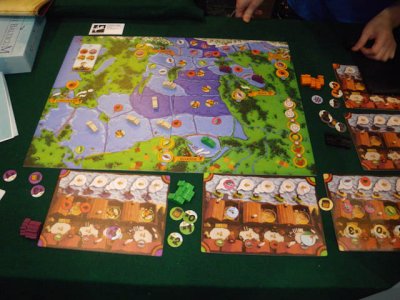 Today there were also more people in guises than yesterday. Those people had once again excellent possibilities to add new weapons, clothings and armors to their collection. As every year I am fascinated in the attention to details of many of the plastic swords and shields. Of course this also has its price. I think that these booths will really be crowded in the next days, when the weekend has begun. 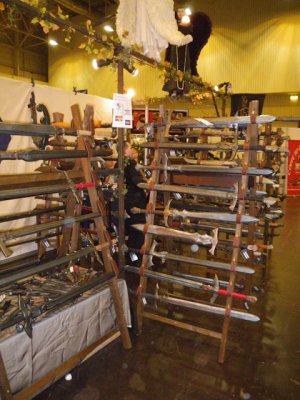 Having left the live role-playing area again I had a look at the Anime-styled games by JAPON BRAND. They came with several deck-building games and I wanted to check if they differ from our successful games of the last years. Only one of the games is completely in English. Tanto Cuore is its name and it is about employing housemaids to your house. They made big advertisement for this game at a well-positioned booth with a lot of tables. I did a try and was a little bit disappointed. Apart from the artwork and the theme it is more or less the same game like Dominion. The only difference is that you can bring some of the cards (the housemaids) to your house, that means that you can separate them from your deck and at the end they can bring you additional victory points.  What is really new about the games for us are the themes. If you think about deck-building games, what do you expect at the moment? Right, a game with a fantasy or Middle Ages theme like Thunderstone or Dominion. But would you also expect a hospital with patients and nurses? Probably not. Dynamite Nurse returns is another deck-building game with a lot of sexy nurses. I made another try and wanted to know if this was only a "Sex sells everything" game or if the Dynamite Nurse returns is also serious game, at least it is a re-publishment of a game that was first published in the early 80s. This game uses a slightly different mechanism. Every player make the running of a monastery hospital. With his cards he must treat patients that come from a dungeon and are badly-hit. New patients are put to an ambulance queue every new turn of a player and can be assigned to any player by the active player. The health of the patients can deteriorate in two stages. If the health of a deteriorated patient once again becomes worse, he dies. Of course this is quite a negative reputation for the monastery and the players gets minus victory points. If a player is "in lead" of dead patients, he gets the dynamite nurse, which gives him some bonuses during the game, but is very bad at the end (a lot of negative VPs). With your deck you can try to heal the patients in your hospital. Of course you can buy new cards from the table to reinforce your deck. Both games work well, but you really should be a fan of the Anime-style, because the games - compared to other modern deck-building games - are quite expensive and cannot bring you total new game mechanisms. 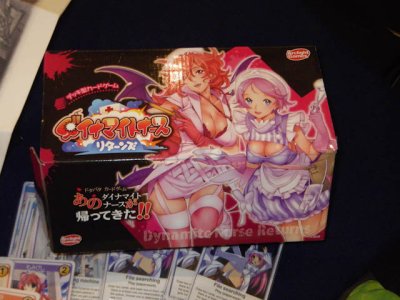 Playtesting session: SAKE & SAMURAI (Albepavo, Booth 9-60)
Sake&Samurai is a card game that uses wooden counters to determine the range between two players. At the beginning of the game, every player places his Samurai card three steps (wooden counters) from his neighbours. He then takes one Katana card, the Japanese longsword for the Samurai. Additionally he gets four cards into his hand. Every card can be taken for different actions. In the corner of the cards, you can find the values for attacking, defending, movement and drinking (the Samurais start the game sober and a lot of Sake must be tippled before it is time for the showdown...). Each card has also a special function that is explained in a text box in the midlle of the card. This can be an event, a special weapon or item, a Minion who helps the player fighting against the other players or an interrupt that allows to play the card even if it is not the player's turn. The crux of the matter is that you may only use either the values in the corner or the text of the card. In a turn a player can play up to two cards. This can be an attack, a movement, a drinking or the special ability of the card. Attacking other players is one of the important things of the game, but it is not so easy to reach the other players. Each weapon has its characteristic range, so that you must be at the exact distance from your opponent to use it. So you always must plan your movements in advance to be at the right distance to attack. The result of an attack is determined quite easy: the attacker sums up his attacking values, and the value of a weapon with the right range that was played before and lies in front of the player. The defender may also use a weapon that lies before him and adds this to the defense value on the card he plays as a defence. The difference between the two is the loose of life points for the defender. I think I do not really have to explain what the movement action is for. Again the card played determines how many steps a player may move in the one or other direction. Weapons are placed before a player, so you always can judge the strength of your opponents at given distances. Drinking is the last action, a sensual one, but also an action you have to choose to win the game. The reason for this is, that in the end the drunkest surviving Samurai wins the game. The fly in the ointment is that - as you will know - alcohol let you forget how to use your weapons and items. Whenever you choose to booze, you must place the Sake card on one of your weapon or item cards in front of you. As an alternative you also may put it on your Life points or on your character, but then you loose your special ability and the chance to take one or more of your life points as hand cards into your hand. But what happens with the poor fellows who do not survive an attack. In most games these people can serve drinks or go to the toilet until the game ends. Other in Sake&Samurai. Killed Samurais become Spirits of Enma and from then on try to prevent the other players to win the game and steal them their Sake drinks or get up to nonsense like adding or removing steps between the players or taking cards from one and giving them to another player. Like the debut game from ALBEPAVO Sake&Samurai has a great artworks. In fact, only yesterday I heard that it has won the LUCCA COMICS AND GAMES 2011 - MIGLIOR PROFILO ARTISTICO (for best artistic profile), a prize that was given to games like DIXIT and KALEIDOS before. The game was a little bit tricky at the beginning, but after a while it can be played quick. If you are playing with the right people I guess that the theme lets you talk big about drinking and the game should be very entertaining. 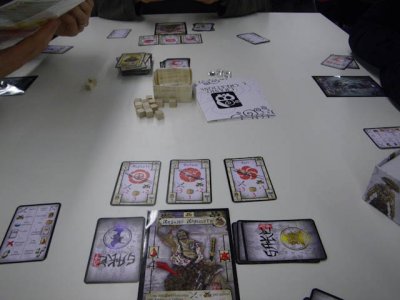 That's it for me for today, have a nice sleep and see you tomorrow again! |
Next on schedule was the International Gamers Awards, and this year our committee once again has shifted the place for the awards ceremony down into the convention halls, since the ceremonies at SAAL ESSEN in previous years seemed to be too remote from the buzz of the fair.
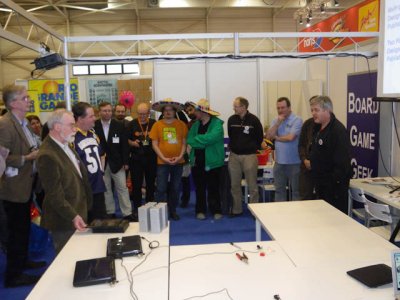
In the absence of our chairman Greg Schloesser the ceremony was held by Stuart Dagger, and in the Multiplayer-Category the International Gamers Awards 2011 was won by 7 Wonders from Antoine Bauza! As said earlier, it's amazing that the game now has won 18 international awards, but I am rather happy for Antoine and Cedrick and Thomas from REPOS for this great success!
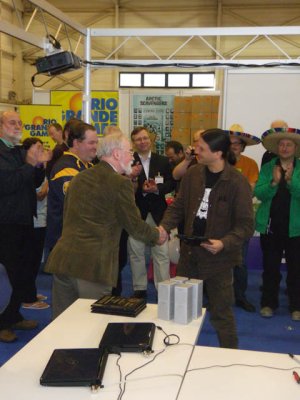
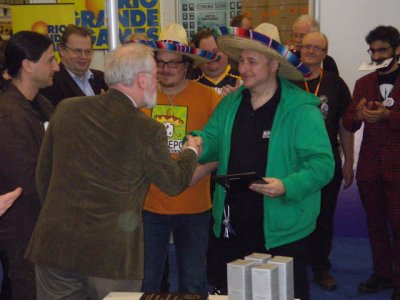
In the two-player category, the International Gamers Awards 2011 goes to Martin Wallace for his game A few Acres of Snow. After his success in 2010, he now could come back once again with another great game!
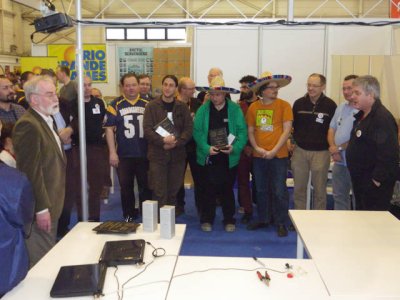
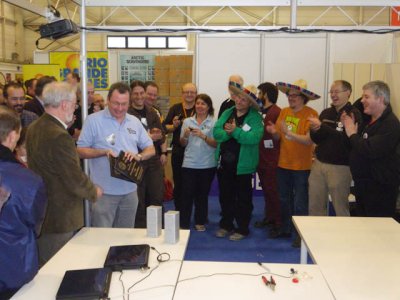
Overall, it was perfect to hold the ceremony at the booth of Boardgamegeek, and so I would like to say a big THANKS to our fellow committee member Scott Alden for making this possible! From my point of view we should definitely repeat this in the years to come!

The afternoon was ticking on, but with some time left I decided to have a look at one more game which had catched my eye already yesterday, and so I went to the booth of HURRICAN to try out the strange-looking new game Dr. Shark!

The setting of this game is known from every James Bond movie: some sinister mastermind is plotting to reach world domination, but instead of getting rid of the pesky special agents he simply invites them to a party where he boasts of his deeds. There is enough evidence available at the party to convict our evil Dr. Shark, but unfortunately all the evidence has been distributed in a deep pool with hungry sharks. However, our daring agents are not frightened by these toothy animals, and so they hop into the pool in the hope to get some of the evidence out!
The evidence against Dr. Shark consists of several items belonging into several groups, and so weapons, costumes, plans and other things can be found in the pool. However, every item has been printed onto two or more puzzle-parts, and all these parts have been placed in a deep black sack out of which they must be fished. However, as the sharks are hungry, the players cannot fish in the sack for too long, and so a sand-timer is used for determining the maximum amount of time which a player may spend for fishing in the sack.
However, the wacky part of the game begins when it comes to the question how a player fishes in the sack. As a matter of fact, the players do not simply draw parts out of the sack, but instead they must choose one of several ways to get the parts out. Since the puzzle-parts have different shapes and backside-textures, the players may choose to fish for different shapes, for parts with the same or with different backside textures, and as long as they draw parts out of the sack matching their chosen search action they can continue to draw if they still have time left. However, the arrival of a shark-part which is also hidden in the sack may end this search rather untimely, and in addition the active player also must stop drawing when he draws out a tile which is not matching the nature of his search action.
Whenever the players have all matching parts to complete one piece of evidence, these parts are discarded and returned into the box, but for this the players receive a victory points token with the value of the token depending on the size of the evidence found. The game is won by the player with most victory points, but while this outlining of the basic structure of the game may leave the impression that the game might be something like an easy party game, be assured that there is much more to this game than might be thought on first sight.
So, the players not only can choose the three kinds of search actions outlined above, but they may also use their time for the search of one specific part, or they may even draw a whole handful of tiles out of the bag. If they succeed in sorting all these tiles into matching colours within the given time, they may keep one tile of each colour (type of evidence) and so the players are ill-advised to take too many parts into their hands. However, the whole search becomes really interesting by the fact that the different textures on the backsides of the parts correspond to the different groups of evidence, so that a player actually can try to draw parts from the sack which match other parts which he has found so far. On the other hand, a big parts overview also is accessible to all players, and so they has to evaluate which search action will be most suitable for their current situation, taking into account that the game only runs over a limited number of turns so that all players must hurry to finish as many pieces of evidence as possible.
Quite nasty is the fact that each different type of search action only may be chosen for once or twice during a round (depending on the number of players), and since the starting player rotates players sometimes have to stick with search actions which they would not have chosen otherwise. Here they have to evaluate the situation, trying to make the best of it in order to keep in the competition.
The game features a perfect graphic implementation with it's Sixties-style and the cute wooden shark which can be used to distract the player who is currently fishing in the sack (or, if you are nicer, just to announce that the sand timer has ended). Even small atmospheric accessories like Dr. Shark's cat which is used for marking the turn number are not forgotten, but even the game itself does not need to hide behind all great looking components. As a matter of fact, Antoine Bauza (yes, it's him again!) and Bruno Cathala have added a very unusual and challenging game of skill to HURRICAN's portfolio of games, and to my mind the game offers both an extraordinary entertainment factor plus a very tricky playing mechanism. This gem should not be underestimated!!!
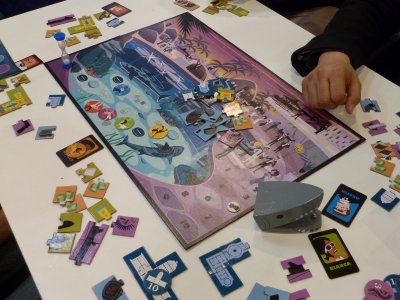
Meeting Bruno Cathala at the booth, I also took the opportunity to talk about today's release of the Cyclades - Hades expansion and the future of the game. Bruno revealed that they are working on an additional expansion adding the possibility to play with up to six players, but the rules for this involve teamplay of two players each and have not been finalised yet. In addition, a new gameboard might be needed as well, and so we will probably have to wait until next year's SPIEL to see more about this

I ended this long day at the show with a visit a reception organised by REPOS GAMES for the celebration of the many awards received by 7 Wonders. There I met Valerie and Dale again, and together we enjoyed some bottles of marvellous Belgian Cherry-Beer! Yummy, that's tasty!!!
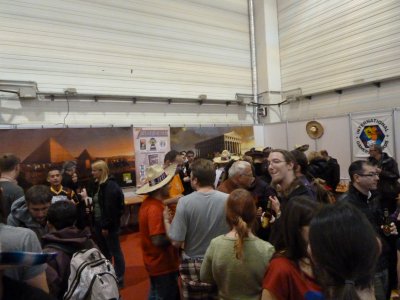

However, I couldn't end the day without revealing the first instalment of this year's
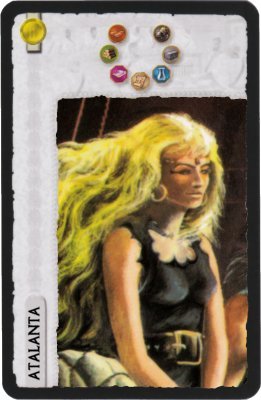
As you can see, it's a Leader-card for 7 Wonders, but more about the nature of this mysterious card will be revealed with the following reports!!!
It's quite late today - 2.40 AM here. See you tomorrow!!!
Welcome back!
Another day at the SPIEL has passed, and although I am starting to get tired there is no room for sleepiness. Tomorrow's finish is approaching, but at the moment we are still in the middle of the show, and so let's start the day directly with another interesting game review!
As I have told you yesterday, the Hades-Expansion for the MATAGOT-game Cyclades had finally arrived, and since I am a big fan of the game I simply needed to to check out this new expansion. Thus, I needed to be in time for the morning opening in order to get a free place at one of the few Cyclades-tables at the ASMODEE both, and I arrived none too soon because people were already crowding in! Still, I was lucky and got a place, and so let me tell you about my experiences with this rather interesting new expansion.
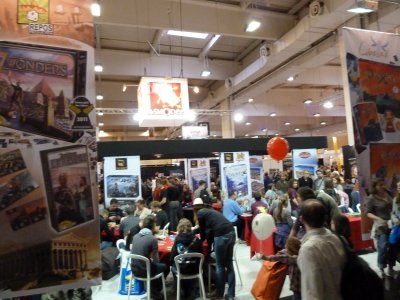
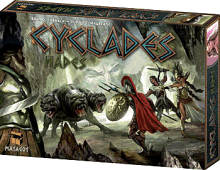 After the successful release of Cyclades at the SPIEL '09 authors Ludovic Maublanc and Bruno Cathala have not forgotten about their mythological game, but instead they have spent some more thoughts on the question how the playing experience might be enhanced. Thus, they have developed a collection of four expansion-modules, and these modules now are released MATAGOT as a combined set in the new Cyclades - Hades expansion.
After the successful release of Cyclades at the SPIEL '09 authors Ludovic Maublanc and Bruno Cathala have not forgotten about their mythological game, but instead they have spent some more thoughts on the question how the playing experience might be enhanced. Thus, they have developed a collection of four expansion-modules, and these modules now are released MATAGOT as a combined set in the new Cyclades - Hades expansion.
All four expansions can be used together, and in total the contents of the new box bring a considerable enlargement of the game's scope. However, in order not to overburden the players with all the new elements, the authors counsel for a stepwise introduction of each module, adding one module at a time until the full amount of four modules is reached.
The first module actually can be played without any of the components of the new expansion box, since it brings a variable setup which can be played just with the components of the basic game. Using this new procedure, each player starts with seven coins instead of five, but none of the players has any armies or ships on the gameboard. Instead, the game is started with a preliminary bidding round, with the players being allowed to occupy two islands in the sequence of the gods which were auctioned. Thus, the players now have a possibility to start from a more harmonious position of two neighbouring islands, and in addition each player receives a special benefit depending on the god which he won in this auction. Thus, Poseidon/Ares mean that their bidders begin the game with an additional fleet/army, Athena grants a philosopher and Zeus a priest. Finally, the player who stuck with Apollo gains one prosperity marker, and this gives him a small compensation for the fact that he was last to choose his starting islands.
The next module brings the introduction of a new God - Hades and his Undead Legion. Hades is not participating in the game right from the beginning, but instead two combat dice are rolled at the beginning of each rounds, ticking down a countdown with their results. When a certain result is reached, Hades will replace one of the gods for the upcoming round, and after the round Hades once again leaves the game and the countdown is reset. But what does Hades do? Being the ruler of the underworld, Hades has a Legion of undead armies and ships at his disposal. The player who wins Hades may pay and use these units during his turn to strengthen his own troops, benefitting from the facts that the armies are cheaper than those of Ares and both ships and armies can be hired at the same time. However, the undead only return for a limited time to the face of earth, and so all undead units must be removed from the gameboard together with Hades at the end of the round. Furthermore, the Hades player may chose to build a Metropolis-sized Necropolis on a fitting island, and whenever an army or ship is eliminated from the board one gold coin will be placed at the Necropolis, waiting to be collected during the income phase by the player who possesses this island.
All legends of ancient Greece are built on the stories of mighty heroes, and so the third module included in Cyclades - Hades introduces some additional mythological creatures and six famous Hero-characters. All of these cards are shuffled into the deck of mythological creatures at the beginning of the game, and the heroes can be recruited in exactly the same way as creatures when their cards appear. Heroes are costly to maintain since they cost their employer an upkeep of two coins every turn, but on the other hand they may mean a decisive edge in combat because each hero not only counts as an army, but also possesses a unique combat skill which gives a special benefit. So, cunning Ulysses negates the effects of a Fort or Metropolis, mighty Hector causes a player who attacks him to lose one army before the combat starts, invincible Achilles counts for two armies, and Amazon-Queen Penthesilea wins all ties rolled during combat without the loss of an army. Famous Perseus on the other hand lets troops retreat from a lost battle, and wealthy Midas can purchase re-rolls of his combat dice as long as his money lasts. Even more, each of the Heroes also possesses a one-time power which can be triggered by a voluntary sacrifice of the hero, and here the special effects all deal with the founding of a Metropolis. Thus, the founding may become cheaper, it may be available for a payment of coins, or the new Metropolis even may be built on the hidden island of the Amazons, immunizing it against all further attacks.
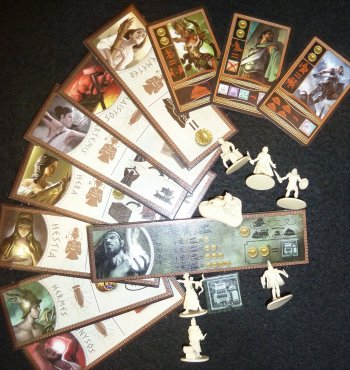
The fourth and last module introduces Divine favours, and when this module is used one random divine favour card is randomly assigned to the second-to-last god which stands for auction each round. These divine favours depict other minor of the Greek Pantheon, and the player who successfully bids for the major god also will receive the benefits of the associated divine favour during his upcoming turn. The benefits depicted on the divine favours are manifold, with each favour showing both an instant free benefit and an additional ability which can be used / purchased during the upcoming turn. The free benefits are either a Priestess or a magic item card, and whereas a Priestess can be used to avoid the loss of a creature or the payment of a Hero's upkeep, the randomly magic item cards will provide yet another special ability which may be applied once. Here the range of abilities is even wider than those listed for the heroes, and so the magic items effectively may influence all phases of the game. This actually also applies to the original one-use abilities of the divine favour's as well, and so the question arises whether the authors have made a step too far towards arbitrariness with the introduction of this last module.
Indeed, the first three modules effectively blend in with the game, and despite the fact that the heroes possess special abilities the general tactical approach is not really changed. As their positioning in the creatures-deck shows, they are of equal value as the creatures, and as their uses are limited to combat or a one-time Metropolis effect their impact on gameplay remains calculable. Quite interesting also is the role of Hades, since his undead certainly can give a strong advantage in combat, but as the legions crumble back to dust at the end of the round the player who used Hades must be aware that his fame comes at a high price, since both Hades himself AND all undead troop units in excess of the first has to be paid for.
However, the situation and the tactical approach changes in a drastic way with the introduction of the divine favours module. Now a vast range of special abilities becomes available both through the favours themselves and the magic objects which may be gained by the favours, and the fact that these effects may apply at many different situations has a somewhat destabilizing effect. Even more, the magic objects are drawn in a totally random fashion, and so one player may greatly profit from the object(s) he gets, while the other may sit on something which may not help him in his current situation. Mind you, the favours and the magic objects nicely enhance the playing atmosphere, but nonetheless their effect on gameplay remains a matter of taste because of the just described observations.
Overall, the somewhat doubtful use of this fourth module does not seem to devaluate Cyclades - Hades on the grant scale, because fans of Cyclades (including myself) certainly will love the expansion for the new variety which becomes available in the game. Thus, the expansion still can be recommended, despite the fact that Hades and the heroes seem to be better balanced than the last module.
After this very delightful start into the convention day, I wanted to check out another expansion set which I was interested in, and this time I needed to get to the booth of HEIDELBERGER in Hall 9 because they are also responsible for the FANTASY FLIGHT GAMES product line here in Germany. As the halls were rather crowded due to the arrival of many families with children, I took the open-air-detour from Hall 12 to the inner courtyard and Hall 9, and once again the courtyard was bathed in bright sunlight. Even though the general temperatures were not a bit chilly, the sun was war enough to warrant a longer stay in the courtyard, and so I met many people who were taking a break from the crowded halls and were happily chatting about their newest discoveries.


Having arrived at HEIDELBERGER, I organised myself a box of the new Sacred Pool expansion for Talisman. Over all these years the liking for this grandfather of fantasy adventure games had not left me, and so I was quite curious about this next step taken towards the total overhaul of Talisman.
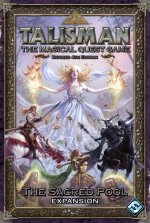 Following the successful marketing strategy of interchanging small and big expansions, the newly refurbished 4th edition of all-time classic Talisman goes into the next round with yet another small expansion pack. This time the players will be allowed to splash in the waters of The Sacred Pool, and once again FANTASY FLIGHT GAMES has not stuck to any traditional Talisman-concepts, but instead the new expansion unites several concepts, ideas and improvements which are rooted in ideas expressed by various fans of the game. So, let's have a look which elements can be found if you fish in The Sacred Pool…
Following the successful marketing strategy of interchanging small and big expansions, the newly refurbished 4th edition of all-time classic Talisman goes into the next round with yet another small expansion pack. This time the players will be allowed to splash in the waters of The Sacred Pool, and once again FANTASY FLIGHT GAMES has not stuck to any traditional Talisman-concepts, but instead the new expansion unites several concepts, ideas and improvements which are rooted in ideas expressed by various fans of the game. So, let's have a look which elements can be found if you fish in The Sacred Pool…
From the flood of over 130 new cards a few specific novelties can be singled out. A major portion of the expansion deals with the advanced introduction of mounts, and so the expansion contains a deck of 12 Stable cards which include Horses, Warhorses and a Horse & Cart. The normal Horses give their owner a quicker movement, whereas a Warhorse may give an edge in battle because the rider may add his Craft to his Strength. The Horse & Cart on the other hand give their owner space for transporting his equipment, and so they increase the maximum number of items which may be carried by their owner. Of course, the new Stable deck is anchored in the game by a number of Adventure cards dealing with mounts, and so the Adventure deck now is enriched by cards like the Animal Market or wild (Enemy) horses which may be kept after a successful combat.
Another novelty which comes with this expansion is a deck of 24 Reward cards. If you remember previous expansions, some of them contained a deck of Quest cards which could be drawn whenever a player visited the Warlock's Cave so that the variety of quests became much bigger. The Reward cards now deal with the other side of the quests, since now a player who completes a quest will not receive a Talisman but instead is allowed to draw a card from the new deck. This deck contains a wide range of benefits ranging from useful one-time effects to increases of a player's characteristics, and while it is true that it becomes a bit harder to get a Talisman by a quest it is a nice twist to get a bit of a surprise when it comes to the completion of a quest.
As it is tradition, the small box contains yet another four characters for the game, and as it seems none of these new characters has any origin in any older version of Talisman. Two of the characters are mounted, the Noble Knight and the Chaos Knight, and as it is suggested by their names the two of them are the antithesis of each other. The Chaos Knight starts the game with a Warhorse, and whenever he kills an enemy he is entitled to draw a new spell (provided his Craft rating allows). The Noble Knight on the other hand starts the game with a normal Horse, and he is not allowed to attack another player's character if he is weaker, but instead he may aid other player characters in combat against an enemy. If the assistance is successful, the Noble Knight will receive one Reward card, but he must miss a turn because it took some time to help the other character. The Cleric is deeply rooted in Fate, and so she may take a Fate counter whenever she prays and she may spend Fate instead of loosing a Life. Finally, the Magus (whose miniature unfortunately falls out of scale with all other miniatures) receives one spell at the beginning of the turn if he does not have any spells, and he may also keep Followers to help him in psychic combat. All in all, a nice combination of interesting new characters!
The expansion also included three new alternative ending cards, and here the Sacred Pool card is most noteable since is means a considerable change to the course of the game. Thus, the players must still reach the Crown of Command space to end the game, but now the game will come to an instant end as soon as the first player with at least four Reward cards reaches the Crown of Command. The Demon Lord ending challenges the players arriving at the Crown of Command to a psychic combat, and the Last Judgment ending means that a player has to roll a dice and look at a table to see whether he has won or lost. All other players have a slight possibility to influence the outcome of the diceroll, but overall this ending seems to be a rather artificial construct which has been included just for the sake of adding another ending.
If you leave this last ending card aside, the contents of the new expansion can be seen as very nice add-ons which once again mean a real enrichment of Talisman. The Stable deck and the Adventure cards dealing with mounts are a good and well-matched way to include mounts in the game, and in comparison to horses known from older editions of Talisman there is less ambiguity towards the interpretation of some of the cards. The characters and the Reward cards also offer new ways to explore the possibilities of the world of Talisman, and so the Sacred Pool certainly is a must-have for people with a liking for Talisman.
However, please be aware that the introduction which I am giving here is actually based on a scan through the different components of this expansion set, since I definitely did not have enough time to start a playtestion session of Talisman here at the show.

After the short trip to HEIDELBERGER I still had a bit of free time, and I wandered through some halls looking at different games until I ended up at the booth of CWALI. Author Corne van Moorsel had come to the SPIEL with a new boardgame named Meltdown 2020, and I couldn't believe my eyes when I saw this game. It's about hazardous atomic incidents in up to seven nuclear reactors, and the players have to use their car, bus and helicopters to get as many as possible of their meeples to an airfield to fly them away and save them from radiation poisoning. Each turn the radiation leakage from one of the reactors on the board may get stronger, and the higher the leakage the more Sievert will be released upon the meeples. If the meeples receive a dose of one Sievert they become ill (the are put on their side), if the dose is increased to two Sievert they become very ill (they are put on their back), and with even more Sievert they die and are removed from the game. So, the players have to evaluate the situation and see which of their meeples they should save first, and they also have to be careful with their vehicles because they may also be lost if they stay in a high contamination area too long.
I am sorry, but I have no understanding whatsoever how this game can be released so short after the catastrophe at Fukushima. It seems very cynic to have "ill" and "very ill" meeples slowly die on the gameboard, and even though it could be questioned at this point why I do not reject wargames with the same vehemence, my answer is that the timing for the release of Meltdown 2020 seems to be totally wrong. Even if the game was in design before the disaster happened, it is my own view that such a game should not be released so soon out of respect for the people who had suffered in Japan.

I needed a break after this surprising find, and so I better let Ralf take over for a while to allow him to give his account of the day…
|
Hello everybody! Today was full of new experiences for me since I visited the convention together with my five year old son for the first time. As you can imagine, the games we watched out for today differed considerably from those which normally trigger my curiosity. Thus, I saw the convention through completely different eyes. Our first stop was the large marble run at the CUBORO booth. I was rather astonished to learn that it is not that easy to build a pro marble run - the children's version my son uses to play with at home is much less complicated to set up. 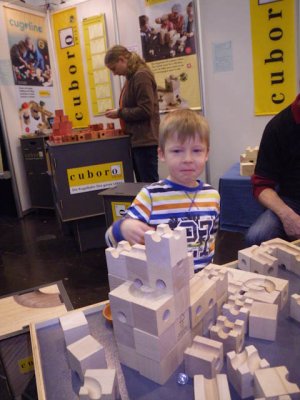 Afterwards, we laid eyes on some of the new releases of Germany's major publisher of children's games, HABA. I also sampled two of the Lego games for younger children, a first-time experience for me! And, I have to confess, this left me really disappointed. The games proved quite boring - even for my son, the representative of the target group - and the much-lauded setup of the game was also nothing to speak of. Maybe the games with higher complexity for older children are more promising, but I certainly will keep my fingers off from those designed for the five year olds. We had a much better time at the MATTEL booth where we sampled some new versions of Uno and a funny game with apes and spillikin the players have to put into a hollow trunk. The apes are placed on top of the trunk at the beginning of the game. Then, players roll a die and remove the spillikin one by one according to the numbers diced. As a result, some of the apes slide down. The active player has to collect all the apes which hit the ground. The game is won by the player who stored up the least number of apes. 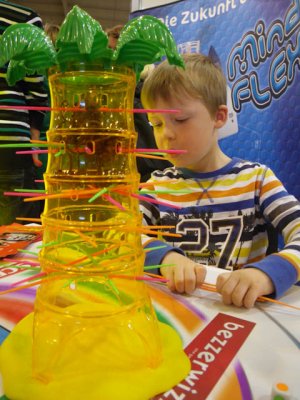 After that it was time to frolic! And the convention offers lots of possibilities, indeed: Bobbycar driving, in-line skating, trampolining appealed most to us and even a bouncy castle was available! 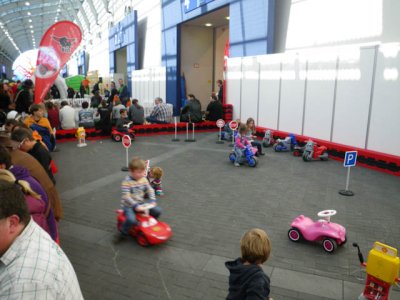 At the end of the day, when my son got tired, I took the opportunity to have a closer look at one of Bernd Eisenstein's new games. Unfortunately, I could not directly participate in the game since all the chairs were occupied; nevertheless, I gained a rather good insight into one of Eisenstein's games by listening to an explanation given to another gaming group and by watching them play. Introduction: PAX (Irongames, Booth 5-92)
Influence cards played into the display also have a special function, depending on the category. The seven categories are Land, Intrigues, Wealth, Fleet, Armies, Religion and Senators. The first two categories, Land and Intrigue, both determine the maximum Fleet and Army cards a player may possess in his display with the caveat that a player is not allowed to collect income in case he or she has played an Intrigue card before. Conversely, after a player has played an Intrigue card, he or she receives the Primus Conspiratus Card which allows him or her to start a new round as long as he or she keeps it. Each set of tree Religion cards in the display allows the player to draw one additional card at the beginning of his or her turn. Thus, the player may take two cards instead of one at a time and then decide where to place them. Senator and Wealth cards both help with purchasing, providing the player with one additional Aurei and reducing the prize for new cards, respectively. Last but not least, Fleet and Army cards wield reciprocal effects when it comes to the final score: The more cards from one category a player possesses, the more bonus cards he receives from the other category. In the end, it is possible for a player to win alone - but only under the condition that the total strength of all the players taken together exceeds the power of Rome. In case Rome's strength exceeds that of any one player in at least four different categories, Rome prevails and shares the triumph with the player who possesses the Primus Conspiratus card which reveals him or her as a traitor. In case Rome fails, the players tally their individual victory points. Victory points are awarded for the number of different category cards a player has still in his display, the categories in which a player outpaces Rome, the number of Army and Fleet symbols as well as the extant money. One victory point is also awarded to the player who keeps the Primus Conspiratus Card, so this card proves extremely important since it offers an advantage in case Rome prevails as well as in case Rome is defeated. The game is played very quickly and will take you no longer than 30 minutes in case you are already familiar with the proceedings. But, even though it seems rather simple in the beginning, you become aware of the manifold tactical opportunities and the funny elements very soon. During the game I monitored players cursed ever so often, being forced to put down a card during the drawing phase and hoping for a better one - only to end up with a still less appropriate card. The game also features an excellent design. And, last but not least, since Pax sells at a very moderate price, it really is a bargain. 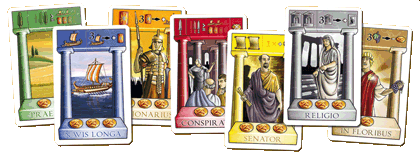 Tomorrow I will do my best to sample Pergamemnon, Eisenstein's second new board game, so keep your fingers crossed that I make it for a vacant chair at the booth's single table! So, now that you know about my schedule for tomorrow I will finally try to get some rest! See you again soon! |
In the meanwhile I had carried on with my own playtesting activities, and here I had made another visit to the booth of 2F-SPIELE because they had another novelty which also seemed quite interesting for a playtest.
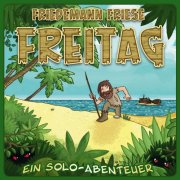
Following his long going "Friday"-project, Friedemann Friese is spending time on fridays to create special games, and after the 2010-release Schwarzer Freitag (KOSMOS) he is now publishing his newest "Friday"-game Freitag under his own label 2F-SPIELE.
The game's name is based on Robinson's companion Friday from the book of Daniel Defoe, and the one and only player in this game takes the role of that character who is helping Robinson to leave the island where he was stranded. So Friedemann Friese has indeed designed a pure solo-game, and this seems to be a quite audacious move because many solo games which were released over the years could not meet the expectations and demands of the gaming market. Indeed, apart from Steve Jackson's and Ian Livingstone's Fighting Fantasy books solo games were most successful in the sphere of wargames, and here VICTORY GAMES' classic Ambush! spings to my mind as a quite perfect blending of a boardgame and a paragraph book. However, leaving the world of cosims aside, good solitaire versions of modern games are hard to come by, and as the Robot-version included in the first expansion for Race for the Galaxy has shown an author must be quite inventive to create a working set of solo rules with a good replay value.
Now it's Friedemann Friese's turn to prove whether he was able to create a solo game which offers a special kick which results in a high replay value, and as indicated he has taken the setting for his game from Daniel Defoe's classic story. And as deckbuilding games have found a growing followership after the initial release of Dominion, Friedemann's Freitag also comes as a modern deckbuilding variant, with the player starting out with a deck of 18-Robinson cards and 20 Lifepoints to face the dangers of his lonely isle.
The central mechanism of the game is fairly easy to grasp. Each turn the player draws two Danger cards from a randomly shuffled deck, chooses one of these cards for discarding and faces the remaining card. The deck of Danger cards is 30 cards strong, and each of these cards actually possesses three different strength values, because the cards get stronger when the deck of Danger cards is exhausted for the first and the second time. After choosing a danger card, the player may start to reveal Robinson cards from his deck, and here the maximum number of cards which may be revealed for free corresponds to yet another value which can be found on the chosen Danger card. Each Robinson card revealed by the player possesses its own strength value, and if the combined strength values of all revealed Robinson cards are higher than the strength of the Danger card the danger is considered to be overcome. In this case the card is placed onto the discard pile of Robinson cards together with the Robinson cards used this turn, and when the player should draw this card at a later point after reshuffling his Robinson cards he will be entitled to use the beneficial effects shown on the lower half of the card.
However, while this streamlined approach sounds fairly easy, such an easy solving of a Danger card is rarely the case in this game. Quite the opposite, the initial cards included in the Robinson deck often have quite low strength values, and so the player will need to use the special effects which can also be found on most Robinson cards. Thus, while facing the current Danger card the player is entitled to use once each special effect which can be found on his revealed Robinson cards, and here the beneficial effects may reach from gaining additional cards or Lifepoints to doubling a card's strength value or the exchange of revealed cards with new cards from the deck. Quite a few different special effects exist, and so a clever, well-timed use of such effects might tip the scales in the player's favour when facing a Danger card.
If the situation cannot be saved just by using card effects and strength values, the player also may choose to give up one or more of his Lifepoints, and in this case he will be entitled to draw one additional card for each Lifepoint which is spent. Lifepoints also are lost when the player looses the contest with the Danger card, but under certain circumstances even this situation might be helpful. Thus, the Danger card may not be taken and added to the deck of Robinson cards if the player cannot overcome it, but on the other hand the player may destroy cards from his hand up to the value of the Lifepoints which were spent.
It might sound strange at this point to talk about the destruction of cards from the player's own deck of Robinson cards, but during the course of the game the player will not only accumulate helpful cards by overcoming Danger cards, but also a negative "Clumsy Fellow" card will be drawn and added to the deck whenever it is used up and must be reshuffled. As fate falls, our Robinson tends to be quite unadept a the task of survival, and so these "Clumsy Fellow" cards actually display a negative strength value which must be substracted from the player's total strength if this card is drawn. Thus, the player will look for a possibility to get rid of such a card, and here it comes handy that cards may be discarded if a Danger card is not overcome.
Independent of the question whether the Danger is overcome, the player will begin his next turn in exactly the same fashion by revealing two new Danger cards from the deck, and once again he chooses one card which he wishes to face this turn. As indicated, the Danger cards get stronger each time their deck needs reshuffling, and when the deck is used up for a third and last time the player has reached the endgame. Now two very strong Pirate ship cards will appear at the horizon, and the player will need to face these two Pirate ships in exactly the same manner as any other Danger cards. However, due to the great strength value found on the Pirate ships, the player needs to be prepared for their arrival, and so he should have increased his decks' performance by the removal of "Clumsy Fellow" cards and the solving of Danger cards with good benefits.
Apart from the exact order of the shuffled decks of Robinson and Danger cards all other information is permanently available to the player, and so the game is not a contest for the player's memory but instead a challenge to make the best of the situation found each turn. Thus, it is quite important that the player ponders the order in which he wants to use the special effects of the Robinson cards revealed during the current turn, and often more than one approach may be found to deal with the currently faced problem. However, it needs a bit of experience to decide which move might be the wisest, and so a newcomer player does well to play his first game of Freitag at the beginner's level.
After a victory at that level the player can slowly increase his challenge by adding additional cards with detrimental effects and reducing his maximum amount of Lifepoints, and these simple adjustments result in a quite demanding challenge especially in the expert game (fourth and highest level). Keeping in mind that Freitag is intended for solo play, the possibility to make the game harder was a great idea to guarantee a longer enjoyment for the player, because my experience with older solo games has shown that a game without a real challenge quickly will loose all player interest.
While the naive graphics used in Freitag can be described as being rather homespun, the rules and playability of the game are situated at a much higher level. Friedemann indeed succeeded in creating a solitaire game which offers a variable degree of difficulty while at the same time keeping true to the chosen background story, and overall the game can be recommended without reservations for all situations where no other person is available to join a game.
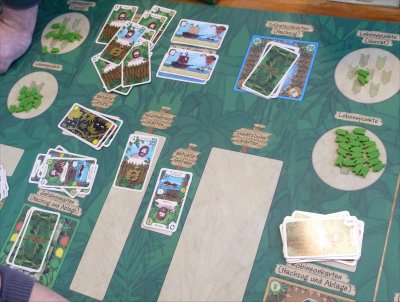
For the afternoon I had reserved a table at the booth of Polish publisher KUZNIA GIER, and on my way I came past the booth of TUNONELA PRODUCTIONS where I met Jussi Autio who had explained to me his project about the "boardgamisation" of the old C64-classic M.U.L.E.. Today I could see that the project had progressed considerably, and so the design of the game had been changed from the early playtesting prototype for a version which is getting close to production.
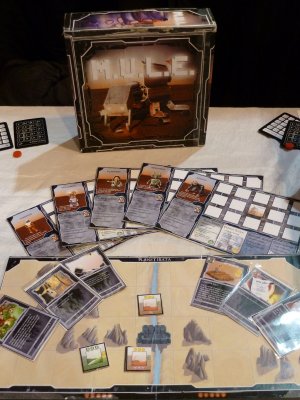
Jussi is hopeful that he will finalise all necessary licensing questions with Programmer Dan Bunten and the original publisher OZARK, and so he and the game's author Heikki Harju soon will start negotiations with publishers to get the game finally started.
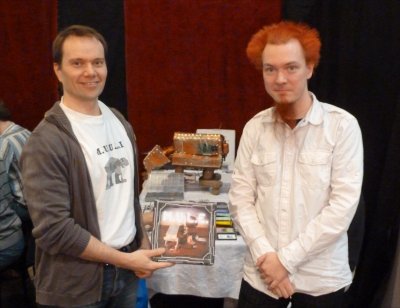
Finally I reached the booth of KUZNIA GIER, and here I was scheduled to participate in an introductory round of the new game Alcatraz - The Scapegoat which had received some quite good buzz here at the show despite its somewhat long-winded name. Indeed, upon my arrival I heard that the game had actually sold out, but of course this did not keep me from participating in the scheduled 45 minutes introductory round.

I guess that everybody knows the prison of Alcatraz by its name, and in this game the players take the roles of prisoners who are plotting an escape from this prison. Six elements of an escape plan must be completed, and at the beginning of the game three task cards for getting such plan elements had been placed at different locations within the prison. Furthermore, and assortment of tokens for tools, clothes, weapons has been placed at various places throughout the prison, and three of these tokens matching the demands shown on a task card must be collected in order to solve the task card and receive an element of the escape plan for it.
Each of the three or four players records the escape plan elements he has collected on his own character sheet, but the whole situation gets interesting on the basis that two prisoners can combine their escape plan elements in order to flee together and win the game. Thus, there is a lot of room for discord and discussion between the players, since no one wants to stay in prison and loose the game. The situation gets even more delicate by the fact that the players have to cooperate to a certain degree, since many of the task cards only can be collected if two prisoners are present at that location at the same time.
However, the main aspect of the game has not yet been mentioned, and this is the name-giving scapegoat of Alcatraz who is determined by a vote of the players at the beginning of each round of play. The player who is voted to become the scapegoat is indeed betrayed by the others, since he is not allowed to complete any task as long as he stays scapegoat. However, to compensate this and to prevent the other players from simply picking the same player again and again, the scapegoat player will get stronger since he will be allowed to carry one additional action for every turn in which he stays scapegoat. In addition, he is entitled to use special scapegoat-cards which can be drawn at the Warden's Office, and these cards are really powerful so that the outcome of a vote always will be influenced by the scapegoat cards possessed by each player.
Thus, the game features and interesting element of discussion and bargaining, and the players also face the dilemma that the Warden has gotten wind of the planned escape. So, the number of guards is increased by at random location each turn, and when a total number of thirteen additional guards has entered the prison without a successful escape all players will have lost the game!
Due to a very efficient instructor and an error made by me our session time was sufficient to finish the game, and the gameplay went very smooth and some interesting developments did arise. However, we have played with a three-player group, and when the other two players finally did flee from the prison I experienced a somewhat hopeless situation. So, the character who is voted scapegoat actually is not barred from fleeing the prison with another player, and as a result the other two players simply voted one of them to become the scapegoat and used his additional actions quite effectively to speed up their efforts to flee. Even though the scapegoat is not allowed to solve a task card, he may gather and hand over equipment tokens to another player. Then the other player used these tokens to complete the needed task card, while I had no possibilities to act against them and get back into the game. Without being the scapegoat, I was barred from using any of my scapegoat cards, and I also had no possibility to catch up with the combined efforts of the others.
I put the main blame for this development on me because I took a wrong player colour in a voting early in the game. This resulted in me becoming the scapegoat in the early phase a bit too often, and so the others collected elements of their escape plans while I was not able to do so. In addition, I underestimated the use of the scapegoat cards, and so I stayed too long without such a card so that the other players had no reason to vote for another scapegoat. Furthermore, their progress made it unattractive for them to negotiate with me, and so they simply acted together to get out of the prison as fast as possible. As I learned, it is important for a player to keep up since the whole game depends on the negotiation process, and so it is essential for a player a player who has become scapegoat to quickly build up a threat for the others by accumulating scapegoat cards.
If you pay attention to these conditions, it should be possible to avoid the situation which I have gotten into, and the development of this first game and the interesting mechanism actually had made me eager for another round. But since the table was already booked, I had to postpone this to a later occasion.
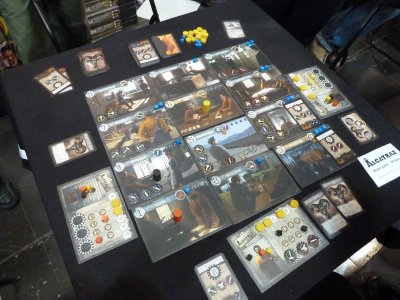
Checking out the booth of AMIGO, I was actually lucky to get a free seat at a table where some players started a round of Tom Lehmann's The City, and as I wanted to check this game out I quickly took the opportunity and joined in for a round of this quick cardgame.
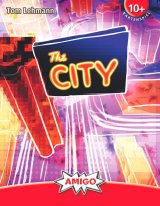 Over the last years AMIGO has demonstrated a good intuition for interesting cardgames, and amongst their small-boxed releases evergreens like Bohnhanza or Wizard can be found side by side with other interesting titles like Friedemann Friese's Friesematenten. This year the ranks of these games is joined by The City, a cardgame designed by Tom Lehmann, author of addictive Race for the Galaxy. Having such a well-known designer, it is no wonder that The City will be given some attention by the boardgaming public, including the fact that it has established a constant position among the top-ten games of the still running Fairplay-voting at the SPIEL '11.
Over the last years AMIGO has demonstrated a good intuition for interesting cardgames, and amongst their small-boxed releases evergreens like Bohnhanza or Wizard can be found side by side with other interesting titles like Friedemann Friese's Friesematenten. This year the ranks of these games is joined by The City, a cardgame designed by Tom Lehmann, author of addictive Race for the Galaxy. Having such a well-known designer, it is no wonder that The City will be given some attention by the boardgaming public, including the fact that it has established a constant position among the top-ten games of the still running Fairplay-voting at the SPIEL '11.
Indeed, the central mechanism known from Race for the Galaxy has been recycled for The City. Thus, the game puts the players into the role of architects, and each player wants to build his own city by playing building cards from his hand. Every building card has a specific cost which must be paid in order to build it, and this payment must be made by discarding a matching amount of other building cards from the player's hand. So, the basic dilemma is once again the decision which card should be played, which cards should be kept for later, and which cards should be discarded to pay for the card played in the current turn.
As indicated, this double use of cards is known from games like Race for the Galaxy or San Juan, but apart from this basic similarity The City operates on a reduced level of rules and playing depth. Quite the opposite, the basic structure of a turn is very straightforward, since all players simultaneously chose and reveal one card to build from their hands, and then all players pay the required building costs by discarding the appropriate number of cards from their hands. After this building phase the turn is ended by the income phase, and now every player receives an income of new building cards as depicted by the income symbols and all buildings in his city. Furthermore, each player generates an amount of victory points, and here the sum once again is depicted by corresponding symbols on the building cards within each player's city.
The game gets interesting by the fact that each building belongs to up to three building categories, and these categories are business, traffic and recreational. Depending on the categories of buildings already built, the players may use the special effects depicted on some of their buildings to create nice windfall effects. So, as an example a Motorway Interchange will generate one card income plus one victory point for each traffic related symbol on a player's buildings, or a City Villa will create additional victory points for each additional City Villa within the player's city. Other cards like the Research Center bring a reduction in building costs for certain other cards, and even other buildings have a building prerequisite which must be met. So, for example, a School only can be built if a City Villa or another housing-type card can be found within the player's city.
As can be seen, there are some interrelations between the different building cards, and a small minority of cards even takes cards found in other player's cities into consideration. So, for example a Subway Network generates one victory point not only for every recreational symbol found on the player's own buildings, but in addition for every recreational symbol found on buildings owned by one other player. However, apart from these very superficial relations all players work on their own, and so there is no real interaction between the players and their individual cities.
As an interesting observation, the reduced scale of The City seems to make a higher level of interaction expendable. The game is played until the round when at least one player has accumulated 50 victory points, and the player with most points at the end of this round will be declared winner. On the relatively short way towards this aim (approximately 20 minutes playing time), the players seem to be perfectly happy with the optimization task they are facing within their own city. Competition is fired by the fact that the game runs over a very limited number of turns, and so the players are satisfied by simply watching the progress made by the others and deciding whether it could be wise to wait for the possibility to play a costly but valuable building or whether a more direct approach with cheaper buildings might be wiser.
Thus, despite the initial differences, The City offers a playing rhythm which is comparable even to its bigger brother Race for the Galaxy. It compensates a reduced playing depth with a much easier playability especially for newcomers, and even seasoned veterans of build-and-development games should enjoy this fast-paced newcomer because of the refreshing approach chosen for a well-known topic. In a way, the The City is much more earthbound than its intergalactic brother, but due to the very reduced scale the approach chosen offers a high attractiveness on its own. All in all, a very interesting game for a quick interlude between two meaty titles or for adding a nutshell building-game to your holiday luggage.
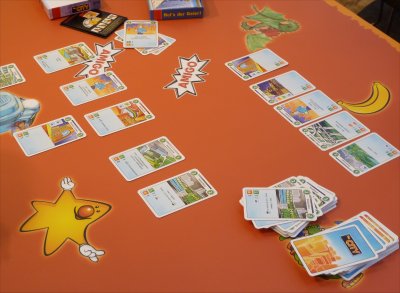
With this account I would actually like to end today's account from the SPIEL. Once again it's 2.30 AM, and so I really need to get some sleep for the final day tomorrow. However, one thing is still missing, and that is the next card for
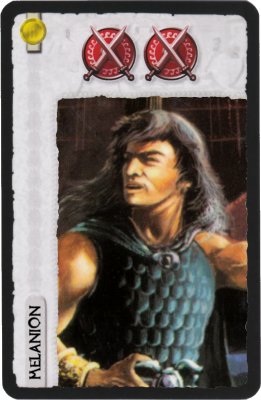
Still no rules for these two cards, but everything will be revealed with the third and last part of this mini-expansion tomorrow!
See you tomorrow for the grand final!!!
And here we go again!
SPIEL-Sunday is always a bit sad, since the last day of the show always leaves a feeling that there were so many more games which I would have liked to play. However, it's already very difficult to get a clear view of the market, and from my perspective it's absolutely impossible to cover the full event. Thus, I have restricted myself to reporting on some chosen games, and this gives me time to provide a more concise write-up of the things I found.
But before going for the final summary of the show, let's first start with today's report. As announced yesterday via Twitter, sunday is traditionally my Lady's Day, and so my wife Nicole had joined me for this last day of the show. Usually I do not schedule any meetings for the last day, and since Nicole's taste of games is sometimes different from the games I would chose, we always make some interesting finds on this day which I otherwise would have overlooked.
However, for the start of the day we had agreed on going directly to Hall 12, since here both the ASMODEE and DAYS OF WONDER booths could be found. We wanted to play Takenoko from MATAGOT, but unfortunately the two tables were the game wasd presented were under siege by dozens of players when we arrived. So we continued to DAYS OF WONDER, and here we got the chance to participate in a round of Smallworld - Underground.
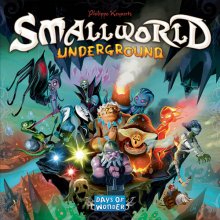 In the world of Harry Potter the large underground building complex of the Ministry of Magic can be entered through a simple telephone booth, but under other circumstances a small building usually will contain a comparatively small cellar. This rule is not different in the caverns below the fabled kingdom of Smallworld, and so the players who have set out to conquer the newly discovered subterranean realm of Smallworld Underground quickly will discover that space is even more restricted in these caverns as on the surface.
In the world of Harry Potter the large underground building complex of the Ministry of Magic can be entered through a simple telephone booth, but under other circumstances a small building usually will contain a comparatively small cellar. This rule is not different in the caverns below the fabled kingdom of Smallworld, and so the players who have set out to conquer the newly discovered subterranean realm of Smallworld Underground quickly will discover that space is even more restricted in these caverns as on the surface.
Indeed, Smallworld Underground builds on the well-tested rules and mechanisms of Smallworld, and the backbone of the game's structure has been implemented in Smallworld Underground on a 1-to-1 basis. Thus, the players chose combinations of races and special abilities, take the appropriate number of troop markers and start their conquest of the subterranean caverns in hope to generate victory points by possessing many regions by the end of their turn. There comes a point when a race cannot expand much further due to the limitation (and possibly loss) of its troop markers, and at that point the player is well-advised to declare the perishing of his active race. This means that the player is allowed to choose a new race at the beginning of his following turn, but he also is allowed to gather victory points from his perished race as long as it is still present on the gameboard.
During the limited number of eight to ten rounds players usually will doom two or three of their races for perishing, and thus there is a lot of conquest action each turn when each player tries to maximize his yield of victory point by enlarging the sphere of influence of his own active race. At the end of each turn each player collects victory points corresponding to the number of regions in his possession, and after the end of the final round the player with most victory points will have won the game.
While it is true that the typical DAYS OF WONDER artwork looks stunningly beautiful as ever, players would expect this new product to contain something more than simply a batch of new races and special abilities. And so, mining a bit deeper below the surface, it may be asked what new elements can be found in Smallworld Underground which actually justify the release of a whole new game.
And indeed, the underworld gameboard offers one type of terrain which cannot be found in the upper world, and this is the river Styx which splits the underground world into roughly two halves. Unless a player's race possesses a special ability which allows the permanent occupation of water regions, these river spaces cannot be permanently conquered. However, unlike the lakes and oceans which are know from the upper world, river Styx may be ferried by all players. In game terms, this means that a player on conquest may place one troop marker at one or more river spaces to cross the river or follow its course upwards or downwards to continue conquest at another point, but after all conquests were made the player must take back all troop markers from the river and distribute them into the other regions containing his troops.
On first sight this change in the landscape seems to be little more than cosmetics, but in effect the river serves as a strategic "Autobahn" (German motorways with no speed limit) which can be used by the players to initiate a quick relocation all across the gameboard. On the one hand, this makes the game a bit more unpredictable and results in a further shift towards a one-turn strategy, but on the other hand conflicts are intensified between players which would not have confronted each other before. This can be seen as a balancing trick, since now a leading player can be hampered with less effort even if his immediate neighbour shies away from this conflict.
So we have got a river. That doesn't impress you much? Then let's dig even deeper, uncovering a further layer of action which was not included in the upper lands of Smallworld!
Some specific underworld regions are assigned not one but by two nicely illustrated monster tiles at the beginning of the game, and just like the Lost Race counters from the surface world these monsters are used to counteract the advantage of being the starting player. However, despite the fact that the monsters unfortunately do not possess any special abilities, their use does not stop with the mere effect of being a placeholder, but instead they are guardians of fabled places and powerful artefacts which can be claimed by a player who successfully conquers such a region.
The game contains a total of 15 different markers for places and artefacts, and whenever a player conquers a region occupied by monsters he is entitled to randomly draw one of these markers. A fabled place must be placed at the region where it is found, and the player may use the special powers connected to this place until the region is taken from him by enemy conquest. An artefact on the other hand may be taken and used in a region of the player's choice, but here the rule applies that the artefact always must be left at the region where it was used last.
Some of these places and artefacts have been designed with a humorous wink, since players now can find a tentacular Great Old One, a fiery Balrog or a Lara Croft like ghost of a Tomb Raider. Other markers among this assortment show the Fountain of Youth, the Sword of the Killer Bunny, a stinking Troll-Sock or a Network of Metal Tubes, and all of these markers give their owners some interesting powers which they will try to use for their benefit. Mind you, these benefits are not strong enough to throw the game absolutely off balance, but nonetheless they can give a decisive edge in critical situations. So, the Tomb Raider's ghost can be sent to any region to immunize it against conquest, the owner of the Fountain of Youth receives an additional troop marker at the beginning of each turn, the Sword of the Killer Bunny allows the conquest of a region with a rebate of two troop tokens etc.
Naturally, this results in the players using their first turn to grab as many of these benefits as possible, but it's likewise foreseeable that other players will become jealous of these boons, and so a lively exchange of blows will take place on the gameboard with each player trying to capture places and artefacts from their opponents. While even the surface version of Smallworld is a very confrontational game, these new elements give an additional incentive for nasty behaviour, and so they effectively add a bit of additional playing depth both in terms of special abilities and tactical planning. In a way, this can be compared to the effect of the Smallworld - Tales and Legends expansion which introduced special conditions for every round of the basic game and also made available some special abilities through auctions. However, some of the Tales and Legends were really powerful, and here the new places and artefacts seem better balanced.
Returning to the initial question, it is difficult to answer whether the new elements really justify the release of a new product while the original Smallworld still is available. For newcomers the answer can be given that they should certainly go for the new Smallworld Underground, because the game contains some elements which were not included in its predecessor. However, for owners of Smallworld the situation is different. While it should be stated here that there is a possibility to use underground races in the open (and vice versa), a good number of races / abilities from each game needs some further adjustments or simply reproduces some element which is present in each game respectively. Furthermore, the 15 places and artefacts and their associated tokens easily could have been released as a slim, low cost Smallworld expansion, and this would have been sufficient to enjoy most of the new Underground-flavour in "basic" Smallworld as well.
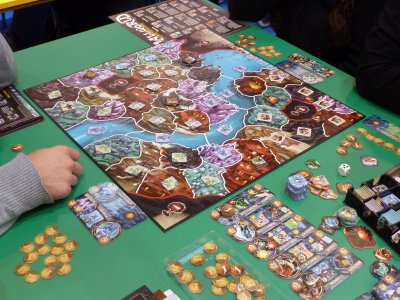
However, there is one additional reason even for Smallworld owners to buy this new game, and this reason stands in direct connection with the SPIEL convention. During the show a special mini-expansion was given out for free here at the DAYS OF WONDER booth, and this expansion can be used to link both the surface and the underworld of Smallworld. So, the Smallworld Tunnels opens up six gateways between both levels, and using both three player boards the game now can be played with up to six players. A very useful giveaway if you have a playing group with this number of players!
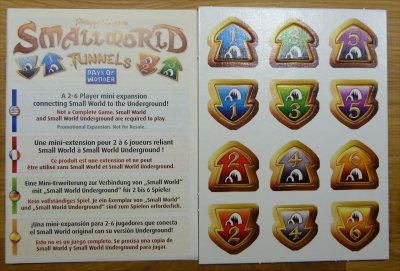
After this playtesting the tables for Takenoko were still circled by waiting people, but Nicole actually found another game at the ASMODEE booth which she wanted to examine. While I usually go for games which follow some kind of story, Nicole really likes to play a more abstract game now and then, and so she got curious when she spied a free table on which Sarena from LUDICALLY was presented.
Before a game of Sarena starts, a randomly drawn playing token is placed at every space on the gameboard. These round tokens actually show to layers of colours - one of the on top and the other colour at the bottom. Each of the two to four players player secretly is assigned one of the four colours available in the game, and during the game the players compete to stack the playing tokens and get their colours onto the top of these stacks, since in the end the player whose colour tops most of these stacks will have won the game.
During his turn, a player may move one token or stack for one space, provided he can either move the token/stack onto another token/stack or moves onto an empty rotation space. A stack only may consist of a maximum of four tokens, and so two stacks cannot be united if their total number of tokens which be higher than four. The rotation spaces on the other hand are activated if a token/stack is moved into them, and in this case the player has to turn the whole token/stack around so that the colour from the bottom now will be on top.
The game is continued in this way with the players building stacks and turning them, or trying to isolate their own tokens so that they cannot make a valid move anymore. When no tokens/stacks can be moved at all, the game will be over and all players count the number of tokens/stacks with their colour on top, and now the most effective player will have won the game.
As indicated, Nicole and I tried out the game with just two players, and here a quite interesting strategic exchange could develop with both of us trying to keep the other from guessing our player colours for as long as possible. However, it must be suspected that this deep strategic orientation will be lost if the game is played with four players, since it seems that too much will happen on the gameboard if a player has to wait for the moves of three other players before he can act again. With just two players, the game was running quite smoothly, and due to its fast-paced character Nicole and I actually played three rounds in a row.
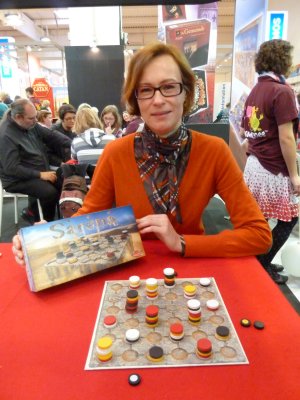
Hall 12 was perfect for us for this first part of the day, since yet another publisher was located there who offered a game which Nicole and I wanted to seen. Thus, we next went to the booth of REPOS PRODUCTION, and here we checked out the new expansion for Ghost Stories, yet another of our favourite games. To enhance the atmosphere, there even was a 3D-version of the game and the new expansion available, and luckily we got a place for us in one of the testing rounds.
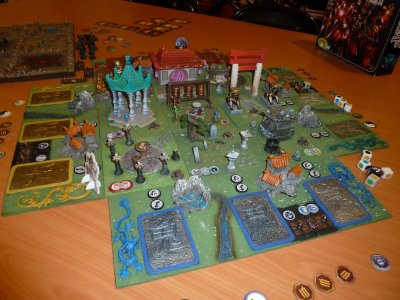
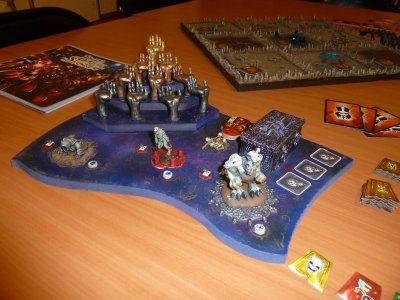
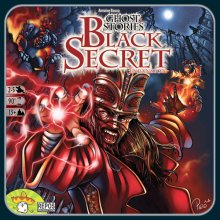 With the introduction of the White Moon expansion Antoine Bauza considerably enlarged the scope of his Ghost Stories boardgame, but as it seems he still had some ideas which were not yet implemented in the game. Thus, the two Belgians from REPOS PRODUCTION once again have brought a new expansion set to the SPIEL '11 convention, and this time the Black Secret expansion deals with the darker aspects of the game.
With the introduction of the White Moon expansion Antoine Bauza considerably enlarged the scope of his Ghost Stories boardgame, but as it seems he still had some ideas which were not yet implemented in the game. Thus, the two Belgians from REPOS PRODUCTION once again have brought a new expansion set to the SPIEL '11 convention, and this time the Black Secret expansion deals with the darker aspects of the game.
In essence, Ghost Stories - Back Secret is an expansion which allows the inclusion of a fifth player, but as the whole symmetry of the game is orientated to a maximum of four Taoists the new fifth player will not join the ranks with the other players. Instead, the new player will assume the role of Wu-Feng himself, and so the mechanisms for the automatic management of all dark elements will be replaced by rules which allow the Wu-Feng player to attack the village protected by the Taoists. In a way, this expansion can be compared to the Whereas expansions adding a fifth or sixth player who follows the same rules as all other players are not unusual, the creation of an expansion allowing a player to assume the role of an antagonist to all other players is much more tricky. On the one hand, the game needs to keep its balance and playability, and on the other hand the new player needs to receive some real instruments to hinder the progress of the other players. It would be quite unsatisfying for a new player to be a "human robot" without any strategic choice, and so Ghost Stories - Back Secret must prove itself to offer a good gaming experience to the new Wu-Feng player.
One of the most striking new elements included in this expansion is a 3 time 3 squares Catacombs board. This board is placed next to the village, and it is aligned in a way to match the general alignment of the village. So, the Catacomb board now introduces the caves below all nine village locations, and during the game the players can move down into the Catacombs and up again on ladders which were placed at every Catacombs space at the beginning of the game. In the catacombs some face down catacomb-tokens are placed, with the number of tokens which is placed at each space depending on the number of Taoists participating at the game. Three urns containing the ashes of Wu-Feng are hidden among these tokens, and Wu-Feng aims to recover these urns in order to activate his ghostly shadow to act within the village.
For the recovery of the urns three different demons stand at Wu-Feng's service, and whenever a new ghost card is drawn the Wu-Feng player may opt to discard the card instead of placing it on a player board and instead summon a demon into the catacombs which is matching the ghost's resistance rating. If one or more demons are present in the Catacombs, the Wu-Feng player is allowed to act with each demon at the beginning of each player's turn, and for his action a demon either can be moved or search the uppermost catacombs token at his current location. As indicated, these tokens may display one of the three urns sought by Wu-Feng, but otherwise a variety of effects may be triggered, ranging from the finding of a Buddha which removes the demon from the catacombs to a pile of bones which Wu-Feng may use to hamper one of the players with a skeleton.
Of course, the players will use their Taoists to stop Wu-Feng from recovering his three urns, and so the time may come when some of them decide to go down into the Catacombs. The level change from the village to the catacombs and back may be done for free directly after a Taoist-movement, provided there is a ladder in the space where the Taoist has moved. As indicated, there are ladders on all catacomb spaces at the beginning of the game, but when a village location becomes haunted the ladder leading to the catacombs from that location will be removed. Even if the location is restored, the ladder will not be returned!
In the catacombs, the Taoists may fight the demons following the usual rules, with their resistance depending on the type of demon and the demon's colour being determined by the catacombs space currently occupied. Furthermore, it should be added here that each demon also possesses a special ability, making it harder to defeat or giving at another benefit like a better searching ability or a special effect which is triggered upon its defeat. A defeated demon is returned to Wu-Feng, but none of the demons may be permanently removed. Instead, Wu-Feng may reactivate them in a later turn in order tore-enter the catacombs. However, it once again costs Wu-Feng a ghost card to re-activate a demon, and as the demons usually have to enter the catacombs through one of two different entries he will also have to avoid Taoists standing on guard, because a catacomb space containing a Taoist cannot be searched for a catacombs marker.
Depending on the efforts Wu-Feng spends for searching his ashes, the time may come when he finally discovers his third urn. At that point all demons will leave the game because they have fulfilled their purpose, and instead a figure symbolizing the shadow of Wu-Feng will be placed on the catacombs space where the third urn was found. At the beginning of each player's turn the Wu-Feng player now may either move his shadow to any space / location of his choice, or - if a Taoist should be present at his current location - attack the Taoist with a roll of three Tao-dice, removing one Qi (life) for each black face rolled. As a third option, the shadow may be used to attack an empty village building at his current location, and in this case the curse dice will the thrown and its effect applied. Unfortunately, the shadow is invincible for the Taoists, and so his presence will hamper them for the rest of the game!
So, whenever a ghost card is drawn, the Wu-Feng player now has the choice of playing a ghost cards in the normal way or to use it to summon a demon, but as a third possibility he may also choose to discard the card to and play one of the curse tokens which were dealt to him at the beginning of the game. These curses can be used in different ways for Wu-Feng's benefit, but to activate stronger curses a pyramid-layout must be followed. So, the activation of stronger curses first requires a base of weaker curses, and so the Wu-Feng player must judge how many ghosts he really can afford to discard for activating curses.
In addition to the use of the ghost cards the Wu-Feng player also is put in control of all incarnations of Wu-Feng. In the basic game a number of Wu-Feng's incarnations simply was added to the lower part of the ghost deck, appearing late in the game and being the ultimate enemies for the players. Now all incarnation cards have been replaced by placeholders, and instead Wu-Feng may draw some incarnation cards from a separate deck during the course of the game. Thus, whenever a placeholder for the activation of an incarnation is revealed, Wu-Feng now can choose which of his incarnations is put into play, and this gives his player a quite powerful choice to activate the incarnations which may be most harmful for the players at this point of the game.
Overall, the correct balancing of his actions poses a considerable challenge to the Wu-Feng player, since he must try to keep the Taoists occupied at the ghost front and the catacombs front at the same time. If one of this fronts is neglected, the Taoists will have a chance to recover, and this usually will mean the downfall of Wu-Feng because only a gradual weakening (and killing) of the Taoists will allow a victory for the forces of evil. However, at this point the initial question for the attractiveness of the new role of Wu-Feng can be answered positively, since the new player really has been equipped with some meaningful possibilities to interact with the other players, and at the same time there is a satisfactory degree of tactical decisions which is demanded of the Wu-Feng player. Multiple options need to be weighted, and apart from the search for the urns it's also quite attractive for the Wu-Feng player to haunt different spaces to destroy ladders in order to cut off passages between the village and the catacombs. Another approach is the collection of incarnation cards, since a broad choice of incarnation cards can give the Wu-Feng player a very strong position in the end game.
As a matter of fact, the new role of Wu-Feng is so strong that a bit of counterbalancing was needed, and this in turn has led to the introduction of the new Bloody Mantra cards which are randomly dealt at the beginning of the game. Whenever a Taoist looses a Qi, that Qi is not discarded but instead placed on a Bloody Mantra card of the player's choice, and when a certain number of Qi has been placed on the card its special ability will be activated. Depending on the Mantra, the Taoists will receive a small benefit which should help them in their mission, and so even the loss of Qi now may have a positive effect.
To make the whole expansion coherent, a new village tile of a Calligrapher has been included, and this tile may be used by the Taoists to place a Qi token from the reserve on one of the Bloody Mantras, and at the same time the Taoist also can chose to replace one of the Bloody mantras in play with one of the unused Mantras which may be more helpful at the current situation. In addition, it should not be forgotten that some curses and some Bloody Mantras have been designed for the simultaneous use of the White Moon expansion, and so Antoine Bauza has taken good care of allowing a use of both expansions at the same time. However, this is only advised to experienced players, since otherwise the somewhat complex rules level will not be easy to handle for newcomers.
To sum it up, Ghost Stories - Back Secret has left a rather good impression, with lots of new contents and a very interesting new perspective which may be explored by an additional player. The expansion is a meaty and harmonious addition to the whole game, and so it can be recommended without reserve.
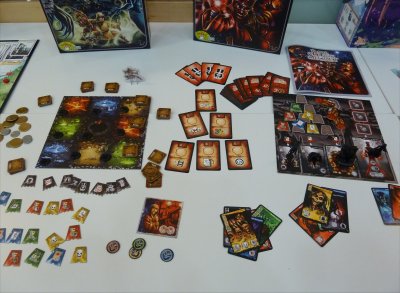
After this session Nicole and I went to have a somewhat belated lunch, and while we are away for eating let's have a look what Ralf was doing on his last day of the show. As we have met him there and exchanged some news, I can promise you that he has played some quite interesting games today!
|
A big welcome back to the final day for my part, too. Today I entered the halls very early and had the chance to see a lot of booths before my first try-out. I could have found a lot of empty seats but I had an appointment with Michele Quondam, the author of last year's highly tactical game Rio de la Plata. Playtesting session: THE FORGOTTEN PLANET (GIOCHIX.IT, Booth 5-53)
Michele again has created a very interesting game, not so complex like the game of the last year, but again it seems to be a masterpiece for tactical games. It is called The Forgotten Planet and is published by the Italian publisher GIOCHIX.IT. A very functional game board, reduced to the absolute basics is somehow unusual in our times, in which even the smallest publishers produce multi-coloured cards and game boards with extraordinary graphical artworks. Still it is not unusual for Michele and GIOCHIX.IT, because once again last year's Rio de la Plata is an example for this. The first surprise: there is no game board necessary for The Forgotten Planet. In an open game only the table surface restricts the area where the players can place their pieces. But you can also choose a fixed game in which you can use angle markers to visualize the game area. Although you do not have the game board, the game tiles must be placed in a square grid. Grid spacers can help to determine the correct distance between the tiles, if they do not lie adjacent. The game tiles are also held very inconspicuous, but maybe exactly this uncommon design attracted the attention of many people at the booth of GIOCHIX.IT. In the game the players are space miners and try to earn the favours of a mighty intergalactical mining company. The trouble is, that of all things we are engaged to do the mining on a very hostile planet. The ground is so unstable that we have to place metal floors, called land tiles in the game, on the ground, before we can send our robots to establish new bases and building mines. And we have a huge competition for the best places on the planet. Other players try to mark out their control area, so that we have to protect us by building walls against their expansions. 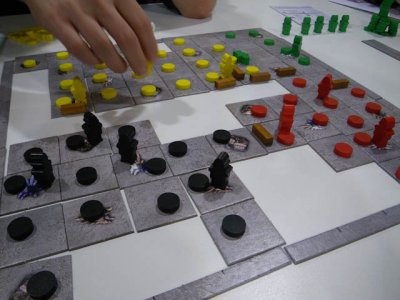 In a turn a player performs four different phases. First of all the player gets his amount of energy, dependent on the land tiles he controls. All of his robots inside his controlled area are switched on, others must be recaptured before they can be used again. The main part of the game is the second phase in which the player performs his actions. With the robot actions, the players can move their robots, build new bases, land or mine tiles, build a wall and push existing walls one step further. All new elements a robot builds are placed to empty spaces orthogonally and adjacent to a robot of the player. So it is very important to have the robots moved to the right positions in the game. The actions are paid by energy, some additionally with resource cubes. This leads us to the other important element in the game, the bases. Base actions are the production of new robots, removing of land tiles that are still available, conserving and concentrating of energies for later rounds and the purchase of resource cubes. The last possible action is the only way to receive victory points during the game and before the final scoring. It normally plays a major role in the end phase of the game. In the next phase, players check the ownership off all landscape and mining tiles. The tile always belongs to the player with the nearest base. Walls block the direct connection and thus can be used to easily move the frontiers. This results in some very tactical possible moves to occupy new land. And additionally you must remember that robots on foreign lands remains switched-off as long as their owner is not able to recapture it. Finally all mines in the area controlled by the player produce new resource cubes. In the end the players are awarded victory points for various conditions. Apart from VP for land and mines owned by the player there are VP for players with most robots, mines and bases. This leads us to the question what one can expect from the game. My try-out hold a lot of promises and I really loved the game. Of course you cannot expect a family game. The forgotten planet must be played very tactical and is more related to traditional games like Go are even Chess. This again fits to the simple design and the easy and short rules. A big advantage in the game is that it ends after the last land tiles are drawn. So there will be no never ending game, a disadvantage in a lot of other tactical games. I think that like other tactical games you must play it several times to really know what to do in which situation. So check my review in a couple of weeks again. 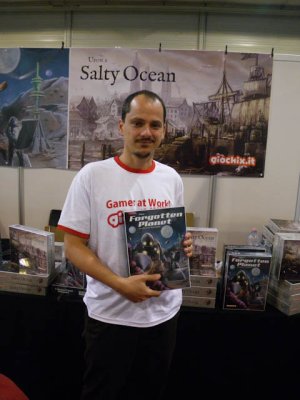 After this promising start, I felt like playing something funny. In the last years we have really seen some uncommon fantasy games. The mighty heroes of former times are suddenly equipped with useless and strange weapons and armours like an electro-mento hut from Super Munchkin. Other games spoof the fantasy genre even further by turning the table and prey on the heroes like in Dungeon Lords or its successor Dungeon Petz. It seems that the players love it - you only have to look at the booth of PEGASUS and the newest expansion for Munchkin. Maybe the reason for the success is that the players feel grown up and - while still fascinated by the genre - they want to distance themselves from their old role-play career. Playtesting session: DUNGEON FIGHTER (CRANIO CREATIONS, Booth 9-57)
But in the last days I had watched people doing some very odd things at the booth of CRANIO CREATIONS. So I went there and luckily fount a seat at a table for their new game Dungeon Fighter. This game follows this line of the other mentioned games even though in a total other direction and even more mad. The basic rules give no reasons to expect any curiosities and do not knock somebody's socks off. Each player takes the role of an Hero and together the party enters a Dungeon. Room by room they encounter different monsters, can equip their heroes with special weapons, armors and items in shops and - if they succeed to survive all the attacks they are confronted with a Boss fight. So you see, nothing unusual so far. But why did all the other people I watched do such odd things. The reason is that Dungeon Fighter uses some very uncommon ways to throw the dices. Some player sat down on the earth, others kept their eyes shut and still others used the arm of their neighbour to throw the dices on an area that looked a little bit like a Dart target lying on the table. And indeed. You have to throw the dices to this target with five concentric zones with increasing numbers and a missed shot zone. The result of an attack is not determined by the side of the die but by the number of the zone the die ends upon. If this was not difficult enough, the die has to bounce once before it lands on the target zone. And this unusual way of determine the amount of damage is influenced by a lot of different special shots that are necessary to use a lot of the weapons. 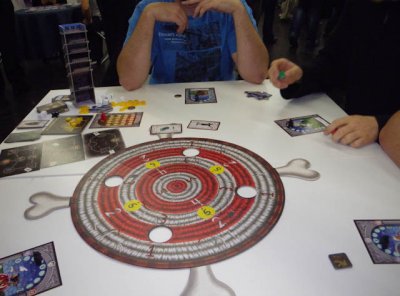 But also some of the monsters demand such crazy shots. For example there are monsters that can only be defeated, if you put the dice upon your forehead and do the roll from there. If know you want to use your weapon, that demands to roll from under the table, you really will have a problem to hit the monster. If you are ready to let yourself go, Dungeon Fighter is pure fun. I cannot judge the long-time replayability, but I really enjoyed my first try-out and I think it is a great party game. By the way, despite of the unusual and funny dice shots, Dungeon Fighter is still a typical Hack and Slay the monsters game that does not have to hide behind some other fantasy games. Maybe you are not identified with your hero like in Talisman, but it still is satisfying to equip your hero with new weapons, armors and potions. 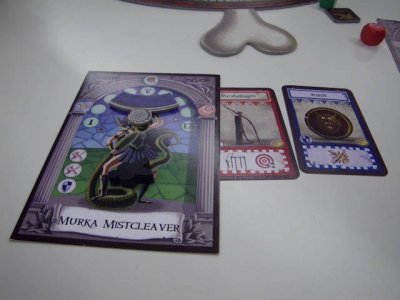 Playtesting session: CORE WORLDS (Stronghold, Booth 5-01)
The central zone of the board is filled with Galactic cards in each round. This is the choice of cards that people can buy or conquer in the round. So in contrast to many other deck-building games you have a changing selection of cards you can choose from. With progressing time, the available cards become stronger and stronger. The available cars can be new Worlds that can be invaded by the players or units, tactics or prestige cards that can be drafted, that means that they are put onto the discard pile of the player and so are added to the deck of the player. To draft a non-world card the player must spend one of his action points and a given amount of energy, called Draft Cost on the card. The energy is a kind of currency and is produced by the worlds of the player's empire in each round. Invading new worlds from the central zone is much more difficult, because the fleet and ground strength of the world must be fought. To do so, a player must have a powerful troop in his warzone. The warezone is a region in front of each player where he can deploy units from his hand. Again this action must be paid with one action point for each unit and enough Energy given on the cards as Deploy Costs. If the warezone is strong enough to invade a world from the central zone (that is the units exceeds the worlds fleet and ground strength), a player may discard these units onto his discard pile and takes the world into his empire. Tactic cards from the hand can help the player to overcome the worlds defence, if the units are not yet strong enough. New worlds are not mixed up in the discard pile, but are placed faced up in front of the player. The new bonuses of the worlds, especially the Energy production can be used from now on, beginning with the next round. With time progressing the players advance more and more to the Core worlds of the galaxy. Consequently the worlds and units are getting stronger. Therefore the Galactic cards are divided into five sectors. Every second round a new sector is reached and the Galaxy cards of the next sector cards are used to fill up the central zone. So the players are equipped with more effective units and tactics, but the worlds become stronger, too, ending with the Core worlds at the end of the game. In the end the players sum up their bonus empire points and the empire points printed on the cards in his stack. Bonuses are granted for special cards or combinations in a stack. So next to the effectiveness one must have a look at the empire points when drafting a new card or invading a world. Core Worlds seems to be a further development of other deck-building games. The interesting thing is that the available cards change during the game and become stronger and stronger. Additionally the mechanism of playing worlds and units to your display to use them in later rounds is a new element that seems to be very logical and effective. If Core Worlds will be a success, they think about an expansion. The cards of the basic game are already equipped with some symbols that do not have any function at the moment but can be activated by an expansion. 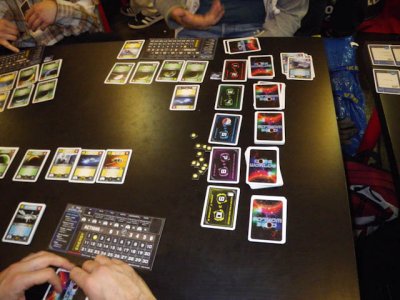 Playtesting session: PERGAMEMNON (Irongames, Booth 5-92)
The game is about an epic showdown between the powerful nations of the ancient world like in all other games from this author at the moment. At the beginning of the game, every player chooses one of the nations that all have certain special abilities. Then he shuffles his starting deck, consisting of the 11 Army cards and draws three of it. The creature cards are shuffled, too, and one half of it is placed face-up in the middle of the table. Finally every player takes one of the Charisma cards and puts it under his nation card. That ends the preparation phase already. On his turn a player can choose between two possible options. First he can recruit a creature from the display. For this the player must overcome the creature's charisma costs with one of his hand cards. He can add to the value of his card Charisma cards from under his nation card. I a player is successful, he puts all of his hand cards together with the creature card onto his discard pile. As customary for a deck-building game, the discard pile is shuffled as soon as the draw pile is empty. Creatures are powerful cards and I learnt that they should be recruited as soon as possible. The only obstacle is that you always must spent at least one of your Charisma cards from under your nation card and there is only one way to get a new one: to be the successful defender in a battle or to be the defender. 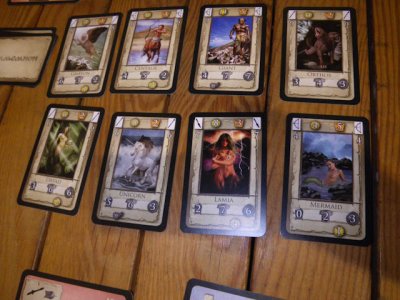 Consequently attacking other players is the second possible action. In Pergamemnon there are three different weapons. Every card uses one of these weapons. But there is only one defence against each of these weapons. For example you need a breastplate if you are attacked by a spear. Now in the battle, the attacker first announces which weapon he wants to take. He then takes one of his cards who uses this weapon. At the same time, the defender chooses one of his cards, who has the right defence. Both cards are simultaneously revealed. Then the values of the attack and the defence, as indicated on the cards, are compared. If the attacker has the higher value he wins at them, but the defender may play another cards as a reinforcement. If then the defence is successful, the defender launches a counter-attack with the top card (if he had played a reinforcement he now attacks with this card. If the attacker cannot defence this counter-attack, he again may play another card from his hand as reinforcement. This can go on, until all cards of the players have been played or if one of the players gives up. The winner of the battle wins all used cards from the other player and puts them together with his own cards on his own discard pile. So you can fill up your deck with other nation's card. But you also can choose to put these card under your nation card where they count as charisma as indicated on the cards and can be used for the purchase action. The game ends if there are less creature cards in the display as the number of players. All players sum up the victory points that are printed on many of the cards. Pergamemnon cannot be compared to other modern deck-building games like Dominion or Thunderstone. There is much more interaction between the players. So you are not only concerned with your own deck, but you must carefully watch what other nations do and find out their weak points. The most interesting part is the battle between two players combined with the special abilities of the different nations. These abilities result in different strategies of the players. For example the Rome player start the game with 5 charisma cards instead of one and the Persian player may hold one card more in his hand. Additionally all nations have their advantages and disadvantages in the fights. Some are very good defenders against bows, other are excellent attackers but cannot defend themselves. Pergamemnon like Pax are both ingenious card games. I asked Bernd Eisenstein why he did not put them in bigger boxes to have them more public appeal. The answer was quite simple: because he did not wanted to blockade to much space in the shelf. I only can agree to this and hope that other players think the same, because both games do not need to hide. 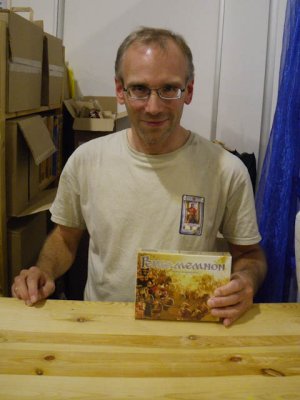 Wow, this definitely was a good last day at the SPIEL. Four playtesting sessions on one of the weekend days certainly are not easy to get, but this year I was really lucky and everything worked out quite well. In addition, there were many very good games available here this year, and so I carried home a quite nice selection of new games which will be played quite frequently in the following weeks! 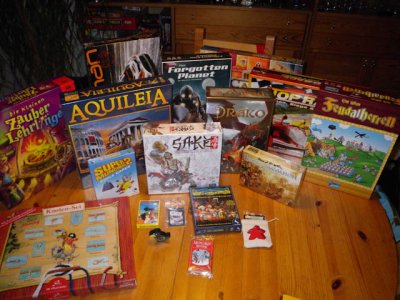 So, please stay tuned to the G@mebox to check our reviews coming in the next weeks. I think this should be interesting, because I saw a lot of new very promising games. See you again next year, and I hope that I will meet the one or other of you again. So long, bye-bye! Ralf Togler |
Well, I have to thank Ralf once again for joining me once more for this year's SPIEL, since his reporting means that some additional games can make it into this report. Furthermore, his experiences in the children's Hall on saturday were quite entertaining for me as well, and this part of the convention certainly would fall out of the scope of my report altogether. But as you could see yesterday, there is so much to do for children that they can spend a fabulous day here at the SPIEL as well.
But let's return to the topic of games, since there are some other games which I would like to present to you before this last day of the SPIEL is over! So, I would like to return to another visit at the booth of FRAGOR GAMES, since I have not yet give you details on their newest game Poseidon's Kingdom.
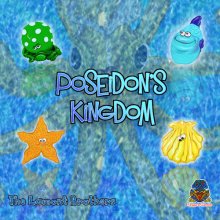 One of the great highlights of the SPIEL each year is not only the reception organised by the LAMONT brothers on each convention wednesday, but from a gamer's perspective the release of their latest game is even more interesting. Over the years the Lamonts have published some extraordinary games dealing with even more extraordinary topics, and so more obscure subjects like ostrich races, stags in heat and unoriented sheep all have become a constituent element of FRAGOR's publishing list. However, all these animalistic topics have not yet touched life below the surface of the great oceans, and so the Lamonts had decided to close this gap with their newest creation Poseidon's Kingdom.
One of the great highlights of the SPIEL each year is not only the reception organised by the LAMONT brothers on each convention wednesday, but from a gamer's perspective the release of their latest game is even more interesting. Over the years the Lamonts have published some extraordinary games dealing with even more extraordinary topics, and so more obscure subjects like ostrich races, stags in heat and unoriented sheep all have become a constituent element of FRAGOR's publishing list. However, all these animalistic topics have not yet touched life below the surface of the great oceans, and so the Lamonts had decided to close this gap with their newest creation Poseidon's Kingdom.
The most obvious news right from the beginning - the cute figures are back! Once again the game contains a set of 13 nicely crafted and painted figures, consisting of four sets of three player figures (octopus, fish, starfish and clam) plus one additional shark figure. Some weeks before the SPIEL '11 the Lamonts announced the release of this new game and opened up a pre-ordering window for roundabout 900 copies of this edition, and all copies were pre-ordered by gaming enthusiasts within the wink of an eye. This quick sell-out disappointed some gamers who had missed the opportunity to pre-order for a number of different reasons, but in a discussion at a BGG-forum the Lamonts explained their standpoint. They see the limited availability of the game as an advantage when it comes to the question whether a larger publisher should re-publish it, because a large initial printrun makes it less attractive for a big publisher to go for another edition. Although such an approach certainly will cause disappointment for unserved customers, it seems perfectly legitimate from a business perspective, and it gets even more understandable if you consider that the Lamonts have to pay for the production and the trip to the SPIEL. If you leave economies of scale aside, a small edition helps to keep costs low, and in addition it makes it more interesting for customers to issue a pre-order as fast as possible. By such an approach usually more copies are sold than by going for a much greater printrun, and so the strategy chosen by the Lamonts seems plausible for a publisher their size.
However, let's now take a plunge into the ocean, and have a look at Poseidon's Kingdom which is hidden beneath the waves. Looking at the whole game presented for the starting-setup, the massive cardboard wave catches the gamer's eye right from the beginning. What use could such a device possibly have, and why are dice positioned on top of the wave? The answer to this is easy - the wave serves as an disproportionate dice cup with a special use! Indeed, during the course of the game the players place dice on certain positions of the wave, and whenever the wave is fully loaded it will be given a gentle push. This causes the wave to turn over, spilling all dice into the different ocean zones of the gameboard, and here they wait to be picked up by the creatures of the players.
The dice used for this procedure are normal six-sided dice, and the players will need those dice for the fulfilment of the game's main goal. A cruel Kraken has taken six friends of each player as prisoners, and in each of his tentacles one of each players' friends is held. In order to free their friends the players need to possess certain combinations of dice, and these combinations range from a total result of "7" for the easiest tentacle over a low double, a high double, three in a row, three of a kind to a total of four different dice. Whenever a player has dice matching these requirements, he may eat them (i.e. return them to the stockpiles) and free his friend from the matching Kraken tentacle. In addition, the player also receives a "safe plaice" token (sorry - Lamont pun) with victory points, but here the rule goes that the first player's to free a friend from a specific tentacle will earn higher points than those coming later.
The players collect the dice by moving one of their creatures on the main gameboard and stopping at an ocean zone with a nice catch of dice, but the movement allowance is not unlimited. Instead, the Lamonts have re-used a very successful concept which could be found in last year's Antics!, since the availability and effectiveness of a player's actions once again is determined by stacking playing pieces into a hill-like structure. In this game the structure is not an anthill but a reef, but this certainly needs some more explanation for a proper understanding.
Each player starts the game with a fixed set of four double-hex coral tiles with which he builds his initial reef, but during the game the players have to chose at the beginning of their turn whether they either load dice from their stockpile onto the wave, or whether they take one of five differently designed coral tiles and enlarge their reef with it. The coral tiles show different kinds of symbols on each of their hexes (halves): an arrow for moving, a wave for the wave-loading capacity and a partly eaten dice to symbolize the dice-collection capacity.
A player always may perform such an action a the most basic level, even if he does not possess a coral tile showing the matching symbol. So, the players are allowed to place one dice on the wave, move one of their creatures for one step on the gameboard, or collect one dice at the current position of one of their creatures. However, during the game the players will start to stack their coral tiles so that the reef will grow not only in width but also in height, and this will enlarge a player's scope of action because the height at which the highest placed symbol is visible within a player's reef determines the effectiveness of this action. Thus, an arrow placed at level three within the reef means that the player may move his creature up to three steps on the board, and likewise the wave-load capacity or the dice-collection capacity can be increased by high-placed coral tiles.
Thus, the players have to choose which enhancements should be made to their reefs, since they will constantly be forced to cover already built parts of their reef to make higher-level placements. In addition, the fourth available symbol on the coral tiles falls out of line with the others, since the empty square symbol shown here may be used to store collected dice. Dice can only be stored at these places, with one dice fitting at a square regardless of the tile's level. However, the players only may keep properly stored dice for their next turn, and so the collection of dice to meet the Kraken's demands also is a question of available story capacity within a player's reef!
While an increase of the dice-collection capacity gives a player the possibility to collect (and possibly consume) more dice with just one action, the increasing of a player's wave load capacity means that a player may load more of his own coloured dice onto the wave at the beginning of his turn. While the players may pick up and consume dice of any colour, the consumption of a player's dice by one of his competitors means that this player may move his third creature which has been placed not onto the gameboard (as the other two), but instead is positioned at the Kraken gameboard. This creature will move in clockwise direction round the Kraken board, making one step per dice consumed by a competitor but jumping over spaces occupied by other player's creatures. Whenever the creature completes a whole round in this fashion, the player is allowed to free his friend from the lowest ranking tentacle at which a friend is still available, and - of course - the player also will receive a safe plaice token with victory points. Even more, the player also may look at one of the eight Kraken coral tiles which have been positioned face down above the Kraken board, and in the last round of the game (when one player has rescued all six of his friends from the Kraken's tentacles) the players also are allowed to eat dice to gain these Kraken coral tiles. In the final evaluation these tiles may give some bonuses depending on the visibility of symbols on a player's reef, and the reaching of such a bonus may give a nice boost of victory points before the game is over.
The introduction of this option for bonus scoring was done quite nicely, because the players are forced to speculate in the course of the game whether they will really be able to get one of the desired Kraken coral tiles with the bonus matching their reef best. Movement of their creatures on the Kraken board may lead to knowledge of contents of some bonus tiles, but even this knowledge is not enough to ensure that the tile may be collected in the final round. This brings up some nice strategic considerations in the endgame, forcing the players to store dice matching the demands for taking specific bonus tiles.
The overview of the rules and mechanics is completed by mentioning the shark who cruises the main gameboard in search of the tasty player creatures, removing any creatures he (m)eets and placing a bone marker on of the player's coral tiles, thus blocking the symbol of that tile. However, the creature is not permanently missing, but instantly replaced by a long -lost brother/sister! In addition, there is also some additional bonus connected with the dice tumbling from the big wave, because the players get a bonus action depending on the total sum of their dice when they wave has chrashed. The higher the sum - the better the action!
Okay, the Lamonts once again have come up with a fiddly set of rules which are not easy to grasp right from the beginning, but once the players have sailed around these initial shallows a very interesting and speculative playing mechanism with some inbuilt tactical challenges comes to the surface. It was a great move to resurrect the hill-building mechanism for another go in Poseidon's Kingdom, since even though Antics! has the benefit of being the premier game to use this mechanism, its use in Poseidon's Kingdom seems to be even more harmonious. Thus, the building of a player's reef forces the player to planning for his following turns, whereas the unpredictable crashing of the wave and the availability of a matching Kraken coral tile at the game's end offer a comparable level of uncertainty. If these aspects are taken together with the great playing components, the game takes a splendid position as an entertaining family game with some nice, surprising twists!
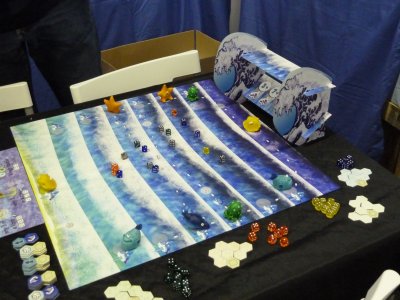
Nicole and I continued on our way to Hall 7 where we wanted to check out a game which Nicole had seen in the novelty show. However, while crossing Hall 4 we used an aisle which I had not crossed yet during this SPIEL, and so I was quite surprised to come upon the booth of HISTORIEN SPIELEGALERIE.
For nine years author Jean du Poel from Oldenburg had not been present at the SPIEL, and I had feared that he had give up the creation of games altogether. So, I was positively surprised to find him back here, and the appearance of his booth brought up some quite fond memories of long bygone times when I was visiting the SPIEL as a child. It must be about 25 years ago when my parents allowed me for the first time to visit the SPIEL on my own, and during that great day I had played Jean's game The American Goldrush 1849 at the booth of HISTORIEN SPIELE. I still remember that the booth had been located in Hall 12 where many big publishers are located today, and the fair was still much smaller since it only covered Halls 10 to 12. However, I was rather taken by the game, and after going home to ask for an increase of my allowance I happily returned to the SPIEL to buy the first boardgame on my own. And today, I once again found this old game here at the SPIEL. My own game was packed in a tube and not in a box, and it still sits cupboard back at home.
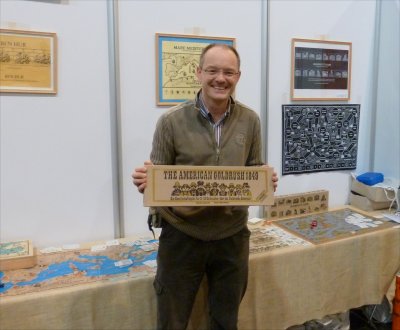
A characteristic of all games from HISTORIEN SPIELEGALERIE is that they are handmade, with lots of wooden components and with gameboards made from a leather-like material. The American Goldrush 1849 is no exception, and as a child I was fascinated to have a Wild-West themed game in which I go dig for Gold, buy stuff at the General Store and challenge other players to a shootout. While moving through the claims, you have to keep an eye on your provisions, because a player who runs out of provisions will starve and has to start anew while leaving all of his former possessions on the gameboard to be picked up by any other player. Although I didn't know at that time, the game's basic principles compare to Talisman-type adventure games, since most of the action on the gameboard is determined through random events which may turned up while mining a claim.
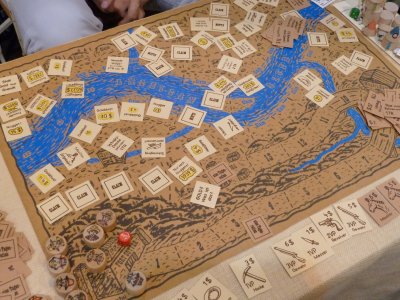
However, Jean also has not only created this adventure game, but instead he has chosen to do games of changing degrees of complexity on different ages of human history. The game which I liked most is Mare Mediterraneum, one of the first Civilization-type games created by a German publisher, and I bought the beautiful deluxe edition of this game some years later when I was a student.
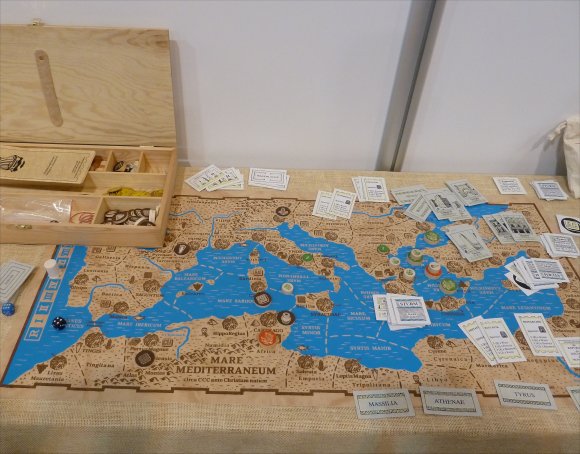
After this fond reminiscence Nicole and I finally arrived in Hall 7, and here we visited the booth of small German publisher KIEHLY. Coming from Bavaria, KIEHLY has brought an abstract but very beautiful tactical game for two people to the show, and after spying the game Moeraki-Kemu in the novelty show Nicole wanted to see whether the game itself was of the same high standards at the playing components.
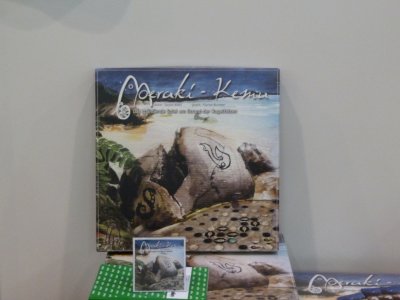
The game actually has a background story, and so it is set on the Southern island of New-Zealand where two tribes of Maori are battling for dominance over a the holy beach. Now this battle is taken out in abstraction, and so each player has a stockpile of marbles which they may place in alternating turns into the holes of the gameboard. It is the aim for the players either to get a straight line of own marbles on the board, or to have a square which is made up from four own marbles. Naturally, the option to build a straight line is better on the outskirts of the circular board, because the lines there are much shorter than those going right through the circle. So, the players have to watch each other's moves, avoid errors and try to build a situation in which the other player has no possibility to block all winning options at the same time.
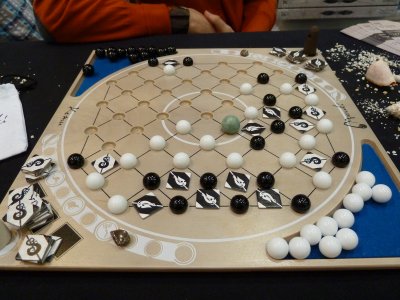
However, some additional components are used to spice the game up, and so a bigger marble must be mentioned which is placed by one player within the inner circle of the board before the game begins. This marble effectively ends all lines which otherwise would go right through its space, and so the placement of this marble opens up the possibility for slight variations of the initial situation on the gameboard.
The game should be played several times in a row, but as the players get better there might come a situation when both players have used up all their marbles and end in a draw. For this reason the game also contains markers for both players, and whenever a player reached a dominance over a space on the board (three of four marbles around one square space are from the same player, or two of three marbles at an outlying space) he may place a marker within such a space to mark his dominance. If no winner has been found through direct victory, these markers will be counted and the player with most markers will have won the game.
Even more, the game also contains a chieftain-stone featuring one eye-like hollow. Each player may place his chieftain once during the game instead of placing a domination marker, and the placement of the chieftain results that all dominance markers within the line of sight of the chieftain must be removed from the board. This may result in quite a blow to the opposite player if the game looks like it may end in a draw.
With these elements, the players face a threefold challenge which is entertaining and addictive at the same time. Of course they try to go for instant victory, but since this option is harder to reach when both players get better, they also should look for placement of as many dominance markers as possible. And, when such markers are placed, the players should look for possible placements of a chieftain, because his use may have a considerable influence on the outcome of a round.
If you remember, I have said earlier in this report that I usually prefer games with a theme, but even though the theme in Moeraki-Kemu is secondary it was not only Nicole who was captivated by the easy but interesting playing mechanism, but I was also drawn into the game right from the beginning. We played this game for nearly an hour - seven games in a row. And, with each new round, we started to discover placement strategies and used ever changing moves to divert each other from our strategy. Thus, the game did not only possess beautiful haptic components, but it also promised short, entertaining challenges for many hours. At the end of the day, we left the show with a copy of Moeraki-Kemu in our bag!
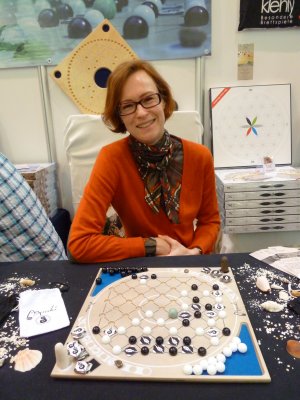
After this interesting find we wanted to call it a day and end our visit to the show, but in the end we decided to have a final check at the booth of ASMODEE for the availability of Takenoko. We came for the booth and saw that the only group waiting for a table just was leaving because they were fed up with waiting, and - even better - five minutes later the gaming group at the table with the large demo set actually ended their game. That was some good luck indeed!
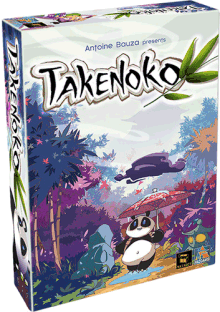
The Japanese word "Takenoko" is a combination of the words "Take" (Bamboo) and "Ko" (Child), and combined with the kanji-syllable "no" the complete word means "Bamboo Sprout". And indeed, bamboo sprouts play an important role in the new MATAGOT-game Takenoko, since the players assume the roles of gardeners who have to take care of a giant, bamboo-eating Panda who was given to the Japanese Emperor by his Chinese counterpart.
During the course of the game the players score victory points by fulfilling objective cards, and three different categories of objectives exist in the game. On the one hand there are gardening objectives which can be fulfilled by completing a certain layout of bamboo tiles in the garden. Next come the gardener objectives, and here a player needs to have bamboo-sections of a certain height on one of more bamboo tiles in the garden. Finally, and in opposition to the gardener objectives come the panda objectives, and these can be fulfilled it a player can feed a certain combination of Bamboo-sections to the giant panda which roams the garden. Each player starts the game with a hand of one objective card coming from each category, but more cards must be drawn as an action during play, because the game ends when a player has completed a certain number of these objectives. Now all players total the victory points from all of their completed objectives, and the player with most points will have won the game.
The situation at the beginning is quite straightforward. Of the garden just one special tile with a pond has been placed, and on this tile the figures of the panda and of the Royal Gardener are waiting for action. Taking turns, the players now have the possibility to take two different actions each, and whenever a player succeeds in completing the task set out on one or more of his objective cards during his turn he may declare this, show the card to the other players and place it onto his own stack of completed objective cards.
As indicated, a player may use an action to draw an additional objective card from one of the three different categories of objective cards, but he may also opt to draw a hand of three bamboo tiles, choosing and placing one of these tiles next to the already placed tiles and discarding the excess tiles. However, the placement of a bamboo tile in the garden is not enough to start the bamboo growing, but instead the tile must receive irrigation in order for the first bamboo section to be placed on the tile. Thus, all tiles placed adjacent to the pond tile are automatically irrigated, but all other tiles must be irrigated by the use of channels which can connect the tile to the pond. Thus, a player may spend his action to take one channel, and he may place it along tile borders so that one channel always irrigates the two adjacent tiles (placement is just like the roads in Settlers of Catan). However, if a player prefers to wait, he may just take a Channel and use it in a later turn together with other channels in order to make a longer connection. Once a bamboo tile is irrigated, a first section of bamboo matching the colour of the bamboo tile is placed on the tile.
Further growth of the bamboo can be reached by moving the Royal Gardener, and a player may use one of his actions to move the Gardener in a straight line for as many bamboo tiles as he chooses. After the movement, one section of bamboo will be added to the tile where the Gardener stopped, but in addition one bamboo section also will be added to all neighbouring bamboo tiles of the same colour. Thus, the bamboo on the tiles can become bigger and bigger, up to a maximum of four sections.
However, the bamboo is in constant danger of being eaten, because the players also may use an action to move the panda. Once again, the movement may be for any number of tiles along a straight line, and where the panda stops he will proceed with his destructive work by consuming one section of bamboo from that tile (if available). The active player may place this section onto his own collection board, and when he has enough sections of the required colour(s) he may use these sections to fulfil an objective card.
As can be seen, competition between the players depends on the kinds of objective cards they have drawn, but usually there will be a conflict of interest between players who want bamboo to grow in a certain height to fulfil gardener objectives and other players who want to consume some of the tasty bamboo with the giant Panda. This competition becomes more pronounced after the first few rounds, since the start phase sees the players more active in terms of placing bamboo tiles and thus fulfilling some gardening objectives.
An additional element of chance comes into the game through the weather dice which each player needs to roll at the beginning of his turn. Depending on the result of the dice, the active player may gain an additional action (sun), a free bamboo section for placement on a tile of his choice (rain), the possibility to perform two identical actions (storm) or a free movement and eating action of the panda (he is frightened of a thunderstorm and needs to hide and recover). The fifth possible results are clouds, and this allows the player to draw a random improvement chip from the reserve. Three different improvements exist in the game, and the player can add them directly or later to a bamboo tile of his choice. One of these improvements is a small pond which will water the tile even if no channel is present, whereas the fertilizer chips mean that two sections of bamboo grow on this tile whenever there is growth. Finally, the enclosure will protect all bamboo on this tile, and the poor hungry panda will not be able to eat any bamboo from there.
The cute comic at the beginning of the rulebook illustrates the general situation in the game. There seems to be quite a bit of chaos, with the players desperately longing to fulfil their gardener objectives but with their efforts constantly spoiled by the ravenous panda. However, the game certainly leaves room for tactical play, and despite the opposite approach Takenoko has some first hand similarities with Hey, that's my fish! by Günter Cornett where ice tiles with fish are stepwise removed (and not added). However, this similarity is only concerning the basic placement and movement principles, since Takenoko chooses a somewhat different tactical approach due to a higher influence of luck cause by the use of the weather dice and the randomly drawn objective cards. Players with a liking for planning games must be aware that they will find their plans thwarted on a regular basis, but on the other hand this is exactly the reason why the game offers a quite high entertainment factor. And, despite the unpredictable results of the weather dice, there are some possibilities to plot and plan, and it's quite fulfilling for a player if everything works out so that multiple objectives can be fulfilled within the same turn.
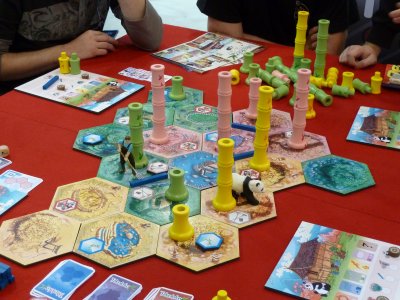
The game was not yet available for sale, but with about two dozen new games waiting at home Nicole and I went home quite merrily with our newly acquired copy of Moeraki-Kemu. However, we will certainly keep our eyes open for this neat new MATAGOT-game!
As all good things must come to an end, we have also reached the end of this year's SPIEL. However, we have not yet reached the end of this report, and so let me finally lift the cover in order to see the complete
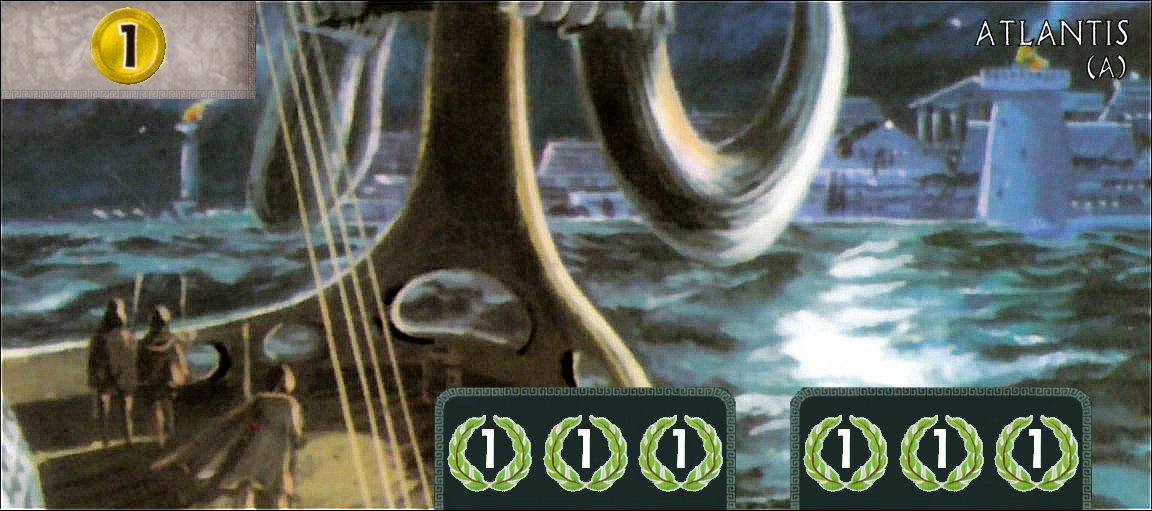
One of the things which makes it worthwhile to attend the SPIEL certainly is the availability of promos and goodies which are distributed by various publishers, but for those of you who cannot attend the show I have established the tradition to publish a selfmade convention special which you may print out and play. This year I have chosen to do something for blockbuster game 7 Wonders, and while the existence of the seven Wonders of the ancient world has been scientifically proved, a great myth which can be found in ancient writings by Platon still is a riddle for archaeology. I am talking about the story of Atlantis, and what would be more fitting than introducing the fabled continent of Atlantis to the game? Thus, I would like to introduce the wonderful city of Atlantis and its two rulers - Queen Atalanta and King Melanion.
This expansion must be played together with the official 7 Wonders - Leaders expansion. The player who plays Atlantis gets both Atlantis character cards (Queen Atalanta and King Melanion) together with the Wonder-card. Both characters are placed partly under the wonder, so that only the portraits but not the character's abilities are visible at the beginning of the game.
Atlantis functions somewhat differently than the other wonders. As you can see, each of the character slots shows three times one victory point, and instead of slowly building a wonder to generate victory points, these points will be scored at the game's end if the points are still visible. However, if a player wants to activate a character for ONE AGE, he must cover one of the victory points with three coins. The coins and the victory point will be LOST, but the player may use the character for the rest of this AGE. This is symbolized by pulling the character out from under the wonder sheet, so that her/his abilities are visible.
Both characters can be activated this way during the same age, but they must be activated FOR EACH AGE SEPARATELY. So, if the player wants to use both characters in all three ages, he has to spend 18 coins (6 times 3), and he will loose all six victory points because all points on the wonder sheet have been covered.
At the end of an age, after the solving of the military conflicts, all activated characters are returned to their initial positions halfway under the wonder so that their special abilities once again are hidden.
Activation of a character does not take up a player's action, but instead it can be done in addition to the player's normal turn. The special abilities of both characters are as follows:
Finally, Atlantis does not produce any kind of resources, but due to its vast riches his owner will get one coin during every turn of the game.
As you can see, these rules try to emulate the observation that the initial richness of Atlantis is slowly depleted ("The Downfall of Atlantis"). Atlantis starts with a lot of victory points and has a good monetary income, but some of this initial fortune must be used if the Atlantis-player wants to use the powers of the royal couple. So, the player has to decide carefully whether the activation of a character is worth the loss of the money and the victory point.
Playtesting has revealed that these rules are fairly well balanced, but if you feel that Atlantis is too strong in comparison to the other wonders you might simply increase the activation costs for a character to four coins. This small rise actually results in the fact that the initial income generated by Atlantis is not sufficient for activating both characters in the same age.
At this point I would also like to thank Cedrick from REPOS PRODUCTIONS for his permission to publish this mini-expansion as a G@mebox Convention Special, and I would love to hear your feedback on the playability of Atlantis!
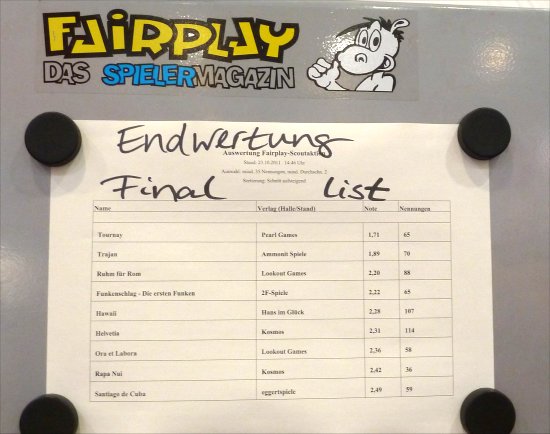
If you look at the final result's of this year's Fairplay Voting made by convention visitors, it's once again quite interesting to see how much my own taste of games differs from that of the average convention visitor. Okay, I have presented to you Funkenschlag - Die ersten Funken which came on fourth rank at Fairplay, but all other games had not interested me enough to start a playtesting session. However, to be fair I have to concede that I have heard some quite good things about Tournay and Trajan, and so you should consult other sources to read a review on these promising games!
And this brings be to a rather difficult choice this year, because I must confess that I was quite undecided which game should receive my special recommendation of the whole convention. Pret-A-Porter and Funkenschlag - die ersten Funken are high on my list because Funkenschlag - die ersten Funken can score with a great re-shaping of the Funkenschlag-mechanism and the successful re-theming of the game, whereas Pret-A-Porter offers a very good, versatile playing mechanism and an outstanding, quite unusual theme. However, there is one game which beats Funkenschlag - die ersten Funken on the field of innovation and Pret-A-Porter with better artwork, and this game is Drum Roll from Konstantinos Kokkinis and Dimitris Drakopoulos. The two newcomer authors from Greece have created a very entertaining and interesting implementation of the Circus-Theme, and I really liked the mechanism that the players have to decide at which point in the game they want to flip their artists. They loose all their special powers, but they start generating victory points after flipping, and so the players have to weight their situation carefully in order to make this decision. A quite interesting challenge!
As it seems, PEGASUS SPIELE also got news about this interesting new game, because they took over the few unsold copies from Konstantinos when the SPIEL closed. I wish this great game and its creators good luck in the hard-fought games market!
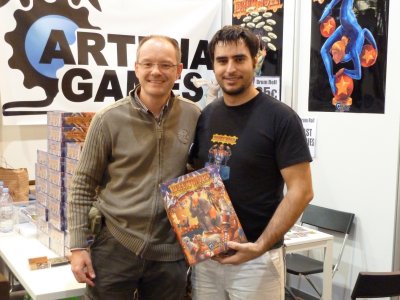
And with this final choice made, the time to say "goodbye" has finally come.
You have followed me around for the last seven days, and once again I hope that I brought the special SPIEL atmosphere to your homes with my reports. It was a great week for me, meeting many of my friends from all over the world and playing a rather promising choice of new games. As indicated, about 2 dozen games now eagerly are waiting to be played again, and so my games collection is well-prepared for the upcoming winter season.
I will keep the Prize-Draw open for a few more days to give stragglers a chance as well, but I am going to post the final winners here and I will also send out notifications via Twitter. Talking about Twitter, I also intend to send out a notification when new reviews are published, but as most of you know this will not be done on a weekly base but depends on my own schedule.
Finally, I would once again like to thank you for all the positive comments you have left in my guestbook. This kind of feedback is needed to keep such this kind of time-consuming reporting going for one whole week, and so I am more than happy to see that many of you have returned once again to read my virtual walk through the convention.
I would like to wish you all the best for the following time, and as the next SPIEL starts on 18th of October 2012 I certainly hope to see you all back for next year's SPIEL-Reports.
Same time, same place!!!
Frank Schulte-Kulkmann
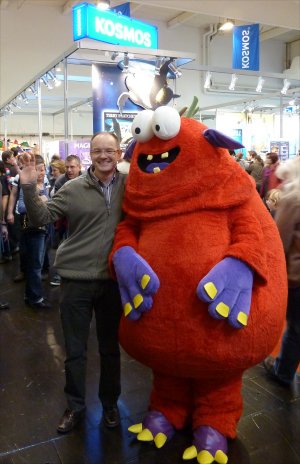
I was knocked out by a cold which I caught during the last day at the SPIEL (Lady's Day was tough...), but now we finally got around to draw the winners of the Prize Draw! And here they are:
Poseidon's Kingdom
Peter Hansson
Souvlaki Wars
Leroy
Convention Goodies
Tarmo Rajamets
Convention Goodies
Sheldon
You can also go by train to Essen Central Station. If arriving there, go to the basement and take the Subway U11 directly to the Messe Essen.
If you want to arrange lodging at Essen, you best contact the Essen-tourism-center by phone 0049/(0)201/19433 or 0049/(0)201/88720-46 or -48. Perhaps they know where some Hotel-rooms are left...
If you travel to Essen by car, please notice that Germany restricts access to many cities (including Essen) for older cars. While the convention area does not fall under these environmental restrictions if you follow a specific route, you might want to check out the route details at the official Messe Essen website. An even better alternative (especially for those of you having a hotel in Essen) would be the acquiring of an Envirnomental Badge which can be ordered at the offical website of the German Technical Inspection Authority.
If you want to have a look at my coverage of previous conventions, follow these links. But you should bring along some time, especially of you want to read the younger reports...
|
| |
|
|
|
|
| |
|
Kulkmann@aol.com
Copyright © 2011 Frank Schulte-Kulkmann, Essen, Germany | |